
ヒンドゥー・ナショナリズム
Hindu nationalism

☆ ヒンドゥー・ナショナリズム(Hindu nationalism) は、インド亜大陸の土着の精神と文化の伝統に基づく社会・政治思想の表現として総称されている。「ヒンドゥー・ナショナリズム」は、हिन्दू राष्ट्रवाद(ヒンドゥー・ラーストラヴァッド)の単純化された訳語である。「ヒンドゥー・ポリティ」と表現する方が適切である。[1] 土着の思想は、インドの政治体制に関する独特なアイデンティティの形成に貢献し[2]、植民地主義を問うための基盤を提供したことで、インドの歴史におい て非常に重要なものとなった。[3] これらはまた、武装闘争[4]、強圧的な政治[5]、非暴力抗議[6]に基づく独立運動の最中、インドのナショナリストたちを鼓舞した。また、インドの社 会改革運動や経済思想にも影響を与えた。[5] 今日、ヒンドゥー至上主義(ヒンドゥー教の「ヒンドゥー性」を意味する)は、インドにおけるヒンドゥー民族主義政治の支配的な形態である。政治思想とし て、ヒンドゥー至上主義という用語は1923年にヴィナヤク・ダモダール・サバルカーによって明確にされた。[7] ヒンドゥー至上主義運動は「右翼過激主義」の一種[8]であり、「古典的な意味でのほぼファシスト的」であり、 均質な多数派と文化的覇権という概念に固執している。[9] 一部の分析者は「ファシスト」というレッテルを否定し、ヒンドゥー至上主義は「保守主義」または「民族絶対主義」の極端な形態であると主張している。 [10] また、ヒンドゥー至上主義を分離主義のイデオロギーであると表現する者もいる。[11][12] ヒンドゥー至上主義は インド人民党(BJP)、ヒンドゥー・ナショナリストのボランティア団体である民族奉仕団(RSS)、サンタサンサ(Sanatan Sanstha)、ヴィシュワ・ヒンドゥー・パリシャッド(VHP)、およびその他の団体によって唱えられている。これらの団体は、サンガ・パリヴァルと 呼ばれる生態系を形成している。[13]
| Hindu nationalism
has been collectively referred to as the expression of social and
political thought, based on the native spiritual and cultural
traditions of the Indian subcontinent. "Hindu nationalism" is a
simplistic translation of हिन्दू राष्ट्रवाद (Hindū Rāṣṭravād). It is
better described as "Hindu polity".[1] The native thought streams became highly relevant in Indian history when they helped form a distinctive identity about the Indian polity[2] and provided a basis for questioning colonialism.[3] These also inspired Indian nationalists during the independence movement based on armed struggle,[4] coercive politics,[5] and non-violent protests.[6] They also influenced social reform movements and economic thinking in India.[5] Today, Hindutva (meaning "Hinduness") is a dominant form of Hindu nationalist politics in India. As a political ideology, the term Hindutva was articulated by Vinayak Damodar Savarkar in 1923.[7] The Hindutva movement has been described as a variant of "right-wing extremism"[8] and as "almost fascist in the classical sense", adhering to a concept of homogenised majority and cultural hegemony.[9] Some analysts dispute the "fascist" label, and suggest Hindutva is an extreme form of "conservatism" or "ethnic absolutism".[10] Some have also described Hindutva as a separatist ideology.[11][12] Hindutva is championed by the Bharatiya Janata Party (BJP), the Hindu Nationalist volunteer organisation Rashtriya Swayamsevak Sangh (RSS), Sanatan Sanstha,[7] the Vishva Hindu Parishad (VHP), and other organisations in an ecosystem called the Sangh Parivar.[13] |
ヒンドゥー・ナショナリズムは、インド亜大陸の土着の精神と文化の伝統
に基づく社会・政治思想の表現として総称されている。「ヒンドゥー・ナショナリズム」は、हिन्दू
राष्ट्रवाद(ヒンドゥー・ラーストラヴァッド)の単純化された訳語である。「ヒンドゥー・ポリティ」と表現する方が適切である。[1] 土着の思想は、インドの政治体制に関する独特なアイデンティティの形成に貢献し[2]、植民地主義を問うための基盤を提供したことで、インドの歴史におい て非常に重要なものとなった。[3] これらはまた、武装闘争[4]、強圧的な政治[5]、非暴力抗議[6]に基づく独立運動の最中、インドのナショナリストたちを鼓舞した。また、インドの社 会改革運動や経済思想にも影響を与えた。[5] 今日、ヒンドゥー至上主義(ヒンドゥー教の「ヒンドゥー性」を意味する)は、インドにおけるヒンドゥー民族主義政治の支配的な形態である。政治思想とし て、ヒンドゥー至上主義という用語は1923年にヴィナヤク・ダモダール・サバルカーによって明確にされた。[7] ヒンドゥー至上主義運動は「右翼過激主義」の一種[8]であり、「古典的な意味でのほぼファシスト的」であり、 均質な多数派と文化的覇権という概念に固執している。[9] 一部の分析者は「ファシスト」というレッテルを否定し、ヒンドゥー至上主義は「保守主義」または「民族絶対主義」の極端な形態であると主張している。 [10] また、ヒンドゥー至上主義を分離主義のイデオロギーであると表現する者もいる。[11][12] ヒンドゥー至上主義は インド人民党(BJP)、ヒンドゥー・ナショナリストのボランティア団体である民族奉仕団(RSS)、サンタサンサ(Sanatan Sanstha)、ヴィシュワ・ヒンドゥー・パリシャッド(VHP)、およびその他の団体によって唱えられている。これらの団体は、サンガ・パリヴァルと 呼ばれる生態系を形成している。[13] |
| Evolution of ideological terminology and influences In the first half of the 20th century, factions of Indian National Congress continued to be identified with "Hindu politics" and ideas of a Hindu nation.[14][page needed] The word "Hindu", throughout history, had been used as an inclusive description that lacked a definition and was used to refer to the native traditions and people of India. It was only in the late 18th century that the word "Hindu" came to be used extensively with religious connotation, while still being used as a synecdoche describing the indigenous traditions. Hindu nationalist ideologies and political languages were very diverse both linguistically and socially. Since Hinduism does not represent an identifiable religious group, terms such as 'Hindu nationalism', and 'Hindu', are considered problematic in the case of religious and nationalism discourse. As Hindus were identifiable as a homogeneous community, some individual Congress leaders were able to induce a symbolism with "Hindu" meaning inside the general stance of secular nationalism.[14][15] The diversity of Indian cultural groups and moderate positions of Hindu nationalism have sometimes made it regarded as cultural nationalism rather than a religious one.[16] 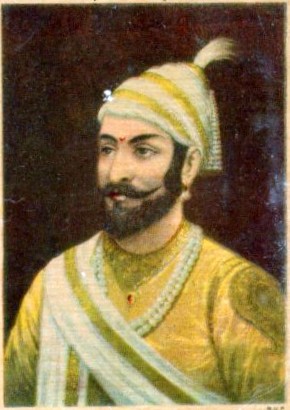 Portrait of Shivaji, the founder of the Maratha Empire Historian Baij Nath Puri writes that the Vijayanagar empire (1336–1646) "was the result of the Hindu nationalist movement against Muslim intrusion and domination of the south".[17] The empire was also administered based on Hindu dharmasastras, and Vedas were the major sources of the prevailing law.[17] Shivaji with his quests is noted to have foun a firm footing for Hindu nationalism in with the foundation of the Maratha Empire.[18][19] Shivaji was also an inspiration for Hindu nationalist activists such as Bal Gangadhar Tilak.[20] Vinayak Damodar Savarkar writes that Shivaji had 'electrified' minds of the Hindus all over Bharat by defeating the forces of Aurangzeb.[21] |
イデオロギー用語の進化と影響 20世紀前半、インド国民会議派の各派閥は「ヒンドゥー政治」やヒンドゥー国民の思想と関連付けられ続けていた。[14][要ページ番号] 歴史を通じて、「ヒンドゥー」という語は定義のない包括的な表現として用いられ、インドの土着の伝統や人々を指すために使われていた。「ヒンドゥー」とい う語が宗教的な含みを伴って広く使用されるようになったのは、18世紀後半になってからであり、それまでは土着の伝統を説明する同義語として使用されてい た。ヒンドゥー民族主義のイデオロギーや政治用語は、言語的にも社会的にも非常に多様であった。ヒンドゥー教は特定の宗教集団を表すものではないため、 「ヒンドゥー民族主義」や「ヒンドゥー」といった用語は、宗教や民族主義に関する議論においては問題があるとみなされている。ヒンドゥー教徒は同質な共同 体として認識されていたため、一部の個々の会議派指導者たちは、世俗的ナショナリズムの一般的な立場の中で、「ヒンドゥー」の意味を持つ象徴を誘導するこ とができた。[14][15] インドの文化集団の多様性とヒンドゥー・ナショナリズムの穏健な立場は、宗教的ナショナリズムというよりも文化的ナショナリズムとみなされることもある。[16]  マラーター帝国の建国者シヴァージーの肖像画 歴史家のバイジュ・ナート・プリーは、ヴィジャヤナガル帝国(1336年-1646年)は「南インドへのイスラム教徒の侵入と支配に対するヒンドゥー・ナ ショナリズム運動の結果であった」と記している。[17] 帝国はヒンドゥー教のダルマ・スートラに基づいて統治され、ヴェーダが支配的な法の主要な情報源であった。[17] シヴァージーは、マラーター帝国の建国により、ヒンドゥー・ナショナリズムの確固たる基盤を築いたことで知られている。[18][19] シヴァージーは、バル・ガンガーダール・ティラクのようなヒンドゥー・ナショナリストの活動家たちにも影響を与えた。[20] ヴィナヤク・ダモダール・サヴァルカルは、シヴァージーがアウラングゼーブの軍勢を打ち破ったことで、バーラタ中のヒンドゥー教徒の心を「電撃した」と記 している。[21] |
| Nepali Hindu nationalism and practices Hinduization policy of the Gorkhali monarch 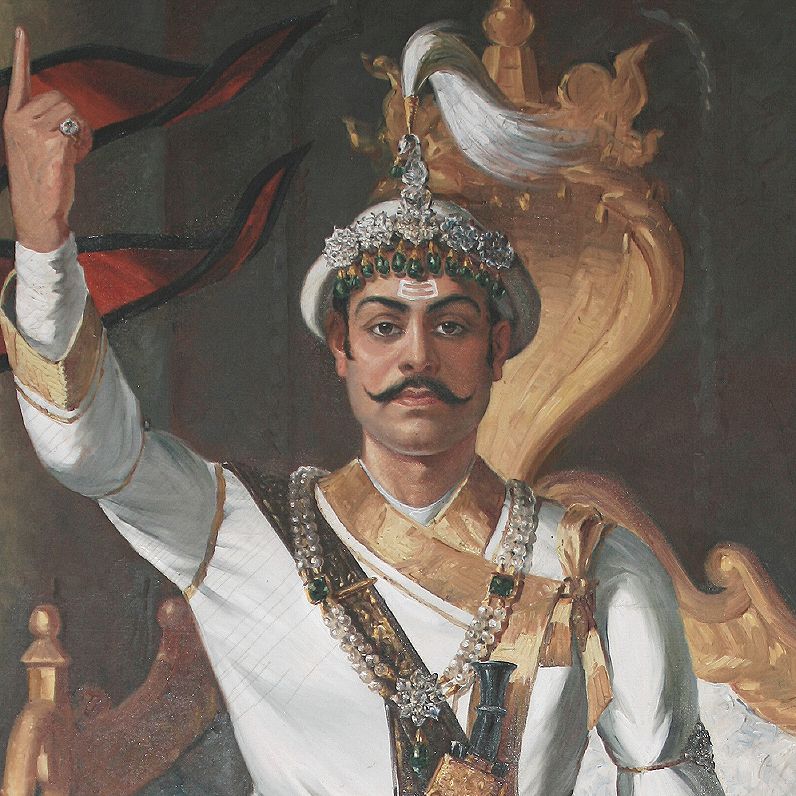 Maharajadhiraja Prithvi Narayan Shah (1723–1775), King of Nepal, propagated the ideals of the Hindu text Dharmashastra as the ruling ideology. Maharajadhiraja Prithvi Narayan Shah proclaimed the newly unified Kingdom of Nepal as Asal Hindustan ("Real Land of Hindus") because North India was ruled by the Islamic Mughal rulers. The proclamation was made to enforce the Hindu social code Dharmaśāstra over his reign and refer to his country as being inhabitable for Hindus. He also referred to the rest of Northern India as Mughlan (Country of Mughals) and called the region infiltrated by Muslim foreigners.[22] After the Gorkhali conquest of the Kathmandu valley, King Prithvi Narayan Shah expelled Christian Capuchin missionaries from Patan and renamed Nepal as Asali Hindustan (the real land of Hindus).[23][full citation needed] The Tagadharis enjoyed a privileged status in the Nepalese capital and they were also given greater access to the authorities after these events.[24][25] Subsequently, Hinduisation became the main policy of the Kingdom of Nepal.[23][full citation needed] Prof. Harka Gurung speculates that the presence of Islamic Mughal rule and Christian British rule in India compelled the foundation of Hindu Nationalism in the Kingdom of Nepal, to build a haven for Hindus there.[23][full citation needed] Ideals of the Bharadari government The policies of the old Bharadari governments of the Gorkha Kingdom were derived from ancient Hindu texts such as the Dharmashastra[26] The King was considered an incarnation of Lord Vishnu and was the chief authority over legislative, judiciary and executive functions.[26] The judiciary functions were decided based on the principles of Hindu Dharma codes of conduct.[26] The king had full rights to expel any person who offended the country and also to pardon the offenders and grant their return to the country.[26] The government in practicality was not an absolute monarchy due to the dominance of Nepalese political clans such as the Pande family and the Thapa family, making the Shah monarch a puppet ruler.[26] These basic Hindu templates provide the evidence that Nepal was administered as a Hindu state. Hindu civil code and legal regulations 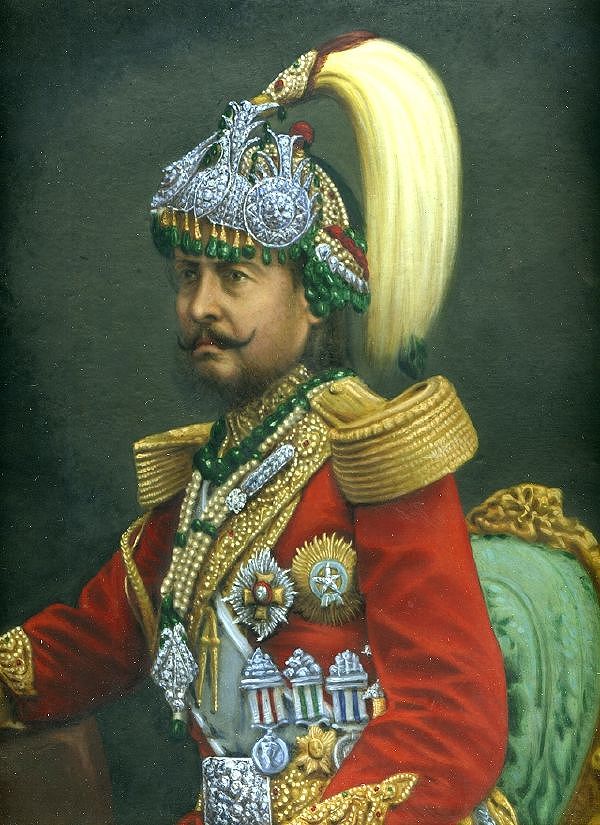 Jung Bahadur Kunwar Rana commissioned the first civil code Muluki Ain in 1854 AD based on traditional Hindu law and prioritized Tagadhari castes before Matwalis and Dalits. The Nepali civil code, Muluki Ain, was commissioned by Jung Bahadur Rana after his European tour and enacted in 1854. It was rooted in traditional Hindu Law and codified social practices for several centuries in Nepal.[27] The law also comprised Prāyaścitta (avoidance and removal of sin) and Ācāra (the customary law of different communities). It was an attempt to include the entire Hindu as well as the non-Hindu population of Nepal of that time into a single hierarchic civic code from the perspective of the Khas rulers.[28][29] The Nepalese jati arrangement in terms of Hindu Varnashrama takes the Tagadhari to be the highest in the hierarchy.[30] The ethnolinguistic group of people of Tamang, Sherpa and Tharu origin were tagged under the title Matwali ("Liquor Drinkers"), while those of Khas, Newari and Terai origin were termed Tagadhari ("Wearers of the Sacred Thread").[30] The Tagadhari castes could not be enslaved following any criminal punishment unless they had been expelled from the caste.[31] The main broad caste categories in Nepal are Tagadharis (sacred thread bearers), Matwalis (liquor drinkers) and Dalits (or untouchables).[32][33][34] |
ネパールにおけるヒンドゥー教ナショナリズムと慣習 ゴークラール君主  マハラージ・ディリジャ・プリティヴィ・ナラヤン・シャー(1723年-1775年)は、ネパール王として、ヒンドゥー教の教典『ダルマシャーストラ』の理想を支配のイデオロギーとして広めた。 マハラージ・ディディラジャ・プリティヴィ・ナラヤン・シャーは、北インドがイスラム教徒のムガール人支配者によって支配されていたため、新たに統一され たネパール王国を「アサル・ヒンドスタン(真のヒンドゥーの地)」と宣言した。この宣言は、ヒンドゥーの社会規範であるダルマシャーストラを自らの統治に 強制し、自国をヒンドゥーにとって居住可能な国であると示すために行われた。また、北インドの残りの地域をムガール人(Mughals)の国 (Mughlan)と呼び、イスラム教徒の外国人が浸透している地域とした。[22] ゴルカ人によるカトマンズ渓谷征服の後、プリティヴィー・ナラヤン・シャー王はパタンからキリスト教のカプチン会宣教師を追放し、ネパールをアサリ・ヒン ドスタン(ヒンドゥー人の真の土地)と改名した。[23][要出典] タガダール朝は、 ネパールの首都で特権的な地位を享受し、これらの出来事の後には当局へのアクセスも拡大した。[24][25] その後、ヒンドゥー化はネパール王国の主要政策となった。[23][要出典] ハルカ・グルン教授は、インドにおけるイスラム教徒のムガル帝国支配とキリスト教徒のイギリス支配が、ネパール王国におけるヒンドゥー民族主義の確立を余 儀なくさせ、ヒンドゥー教徒の避難所を築くことを余儀なくさせた、と推測している。[23][要出典] バルダリ政権の理念 ゴルカ王国のバルダリ政権の政策は、ダルマシャーストラなどの古代ヒンドゥー教の文献から導き出されたものであった[26]。王はヴィシュヌ神の化身とみ なされ、立法、司法、行政の最高権威者であった[26]。司法機能はヒンドゥー教のダルマ行動規範の原則に基づいて決定された[26]。王は、 国を侮辱した人物を追放する権利、また犯罪者を赦免し、その帰国を許可する権利も有していた。[26] 実際には、パンド家やタパ家などのネパール政治一族が優勢であったため、政府は絶対王政ではなく、シャー君主は傀儡の支配者であった。[26] これらの基本的なヒンドゥー教の枠組みは、ネパールがヒンドゥー教の国家として統治されていたことを示す証拠である。 ヒンドゥー教の民法および法規制  ユング・バハドゥール・クンワル・ラナは、伝統的なヒンドゥー法に基づいて、1854年に最初の民法Muluki Ainを制定し、マートワリやダリットよりもタガダリカーストを優先した。 ネパール民法であるMuluki Ainは、ヨーロッパ視察を終えたジュン・バハドゥル・ラナによって制定され、1854年に施行された。これは伝統的なヒンドゥー法に根ざし、ネパールで 数世紀にわたって慣習化されていた社会慣行を成文化したものである。[27] この法律には、Prāyaścitta(罪の回避と除去)とĀcāra(異なるコミュニティの慣習法)も含まれていた。これは、カースト支配者の観点か ら、当時のネパールにおけるヒンドゥー教徒と非ヒンドゥー教徒の人口全体を、単一の階層的市民法に含めようとする試みであった。[28][29] ヒンドゥー教のヴァルナ・シュラマの観点から見たネパール人のジャティの編成では、タガダリが階層構造の中で最も高い位置づけとなっている 。タマン族、シェルパ族、タル族を起源とする民族言語集団は「マートワリ(酒飲み)」という称号で呼ばれ、一方、カース族、ネワール族、テライ族を起源と する民族は「タガダリ(聖なる糸の着用者)」と呼ばれた。 カーストから追放された場合を除き、刑事罰を受けた後も奴隷にされることはなかった。[31] ネパールにおける主なカースト区分は、タガダリ(聖なる糸の保有者)、マトワリ(酒飲み)、ダリット(不可触民)である。[32][33][34] |
| Modern age and the Hindu Renaissance in the 19th century Many Hindu reform movements originated in the nineteenth century. These movements led to fresh interpretations of the ancient scriptures of Upanishads and Vedanta and also emphasised on social reform.[5] The marked feature of these movements was that they countered the notion of the superiority of Western culture during the colonial era. This led to the upsurge of patriotic ideas that formed the cultural and ideological basis for the independence movement in Colonial India.[3] Brahmo Samaj The Brahmo Samaj was started by a Bengali scholar, Ram Mohan Roy in 1828. Ram Mohan Roy endeavoured to create from the ancient Upanishadic texts, a vision of rationalist 'modern' India. Socially, he criticized the ongoing superstitions,[35] and believed in a monotheistic Vedic religion. His major emphasis was social reform. He fought against Caste discrimination and advocated equal rights for women.[36] Although the Brahmos found favourable responses from the British government and Westernized Indians, they were largely isolated from the larger Hindu society due to their intellectual Vedantic and Unitarian views. However their efforts to systematise Hindu spirituality based on rational and logical interpretation of the ancient Indian texts would be carried forward by other movements in Bengal and across India.[3] Arya Samaj 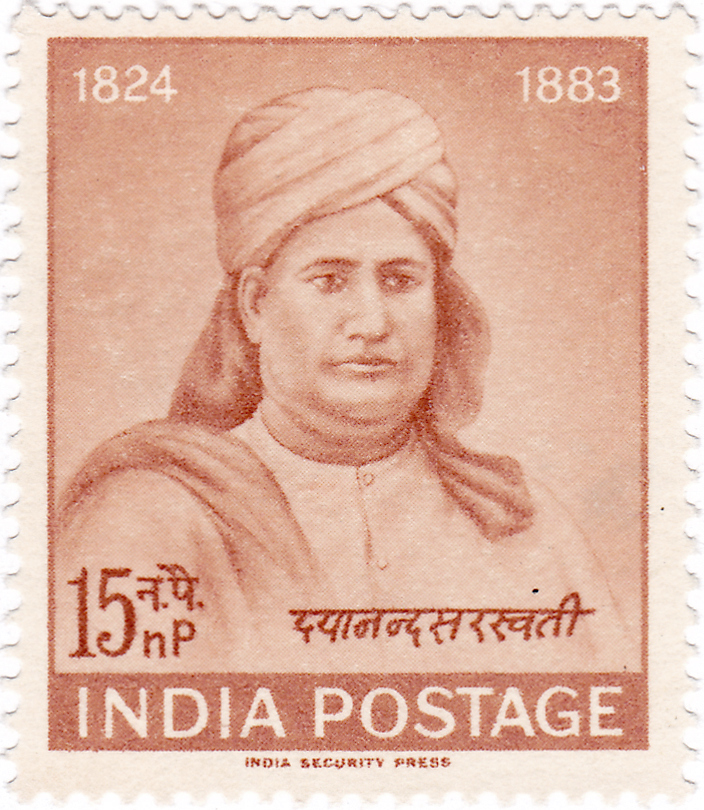 Maharishi Dayananda Saraswati, founder of the Arya Samaj, on a 1962 stamp of India Arya Samaj is considered one of the overarching Hindu renaissance movements of the late nineteenth century. Swami Dayananda, the founder of Arya Samaj, rejected idolatry, caste restriction and untouchability, child marriage and advocated equal status and opportunities for women. He opposed "Brahmanism" (which he believed had led to the corruption of the knowledge of Vedas) as much as he opposed Christianity and Islam.[5] Although Arya Samaj was often considered as a social movement, many revolutionaries and political leaders of the Indian Independence movement like Ramprasad Bismil,[37] Bhagat Singh, Shyamji Krishnavarma, Bhai Paramanand and Lala Lajpat Rai were inspired by it.[38] Swami Vivekananda  Swami Vivekananda on the Platform of the Parliament of the World's Religions Another 19th-century Hindu reformer was Swami Vivekananda. Vivekananda as a student was educated in contemporary Western thought.[3] He joined Brahmo Samaj briefly before meeting Ramakrishna, who was a priest in the temple of the goddess Kali in Calcutta and who was to become his guru.[3] Under the influence of Orientalism, Perennialism and Universalism, Vivekananda re-interpreted Advaita Vedanta, presenting it as the essence of Hindu spirituality, and the development of human's religiosity.[39] This project started with Ram Mohan Roy of Brahmo Samaj, who collaborated with the Unitarian Church, and propagated a strict monotheism.[39] This reinterpretation produced neo-Vedanta, in which Advaita Vedanta was combined with disciplines such as yoga and the concept of social service[39] to attain perfection from the ascetic traditions in what Vivekananda called the "practical Vedanta". The practical side essentially included participation in social reform.[3] He made Hindu spirituality, intellectually available to the Westernized audience. His famous speech in the Parliament of the World's Religions at Chicago on 11 September 1893, followed a huge reception of his thought in the West and made him a well-known figure in the West and subsequently in India too.[3] His influence can still be recognised in popular Western spirituality, such as nondualism, New Age and the veneration of Ramana Maharshi. A major element of Vivekananda's message was nationalism. He saw his effort very much in terms of a revitalisation of the Hindu nation, which carried Hindu spirituality and which could counter Western materialism. The notions of the superiority of Western culture against the culture of India, were to be questioned based on Hindu spirituality. It also became a main inspiration for Hindu nationalism today.[3] One of the most revered leaders of the Rashtriya Swayamsevak Sangh (RSS), Babasaheb Apte's lifelong pet sentence was "Vivekananda is like Gita for the RSS." Some historians have observed that this helped the nascent Independence movement with a distinct national identity and kept it from being the simple derivative function of European nationalism.[2] |
近代と19世紀のヒンドゥー・ルネサンス 多くのヒンドゥー教の改革運動は19世紀に始まった。これらの運動は、ウパニシャッドやヴェーダーンタといった古代の聖典の新たな解釈につながり、また社 会改革も強調された。[5] これらの運動の顕著な特徴は、植民地時代における西洋文化の優越性という概念に異議を唱えたことである。これは、植民地インドにおける独立運動の文化的・ 思想的基盤となる愛国的な思想の高まりにつながった。[3] ブラーマ・サマージ ブラーマ・サマージは、1828年にベンガルの学者ラム・モハン・ロイによって創設された。ラム・モハン・ロイは、古代のウパニシャッドのテキストから、 合理主義的な「近代」インドのビジョンを創り出そうと努めた。社会的に、彼は当時蔓延していた迷信を批判し[35]、一神教のヴェーダの宗教を信じてい た。彼の主な関心は社会改革にあった。カースト制度による差別と戦い、女性の権利を主張した。[36] ブラフモは英国政府や西洋化されたインド人から好意的に受け止められたが、ヴェーダーンタ哲学やユニテリアン的見解という知的背景から、ヒンドゥー教社会 からは概ね孤立していた。しかし、古代インドのテキストを合理的に論理的に解釈し、ヒンドゥー教の精神性を体系化しようとする彼らの努力は、ベンガル地方 やインド全土で他の運動によって引き継がれることとなった。[3] アーリア・サマージ  アーリア・サマージの創設者、マハリシ・ダヤナンダ・サラスワティ。1962年のインドの切手 アーリア・サマージは、19世紀後半の包括的なヒンドゥー教復興運動のひとつと考えられている。アーリア・サマージの創設者であるスワミ・ダヤナンダは、 偶像崇拝、カースト制度による制限や不可触民、児童婚を否定し、女性の地位向上と機会均等を提唱した。彼は「バラモン教」(バラモン教がヴェーダの知識の 腐敗を招いたと信じていた)に反対するのと同様に、キリスト教やイスラム教にも反対していた。[5] アリア・サマージはしばしば社会運動とみなされていたが、 ラームプラサード・ビスミル、バガット・シン、シャムジー・クリシュナヴァルマ、バイ・パラマナンド、ララ・ラージパト・ライといったインド独立運動の革 命家や政治指導者たちは、この思想に影響を受けた。 スワミ・ヴィヴェーカーナンダ  世界宗教会議の演壇に立つスワミ・ヴィヴェーカーナンダ 19世紀のヒンドゥー教の改革者としては、スワミ・ヴィヴェーカーナンダも挙げられる。学生時代のヴィヴェーカーナンダは、当時の西洋思想に精通してい た。[3] 彼はブラフモ・サマージに一時的に参加した後、カルカッタの女神カーリーの寺院の司祭であり、後に師となるラーマクリシュナと出会った。[3] オリエンタリズム、ペレニアル主義、ユニバーサリズムの影響を受け、ヴィヴェーカーナンダはアドヴァイタ・ヴェーダーンタを再解釈し、ヒンドゥー教の精神 性の本質として提示し、人間の 。このプロジェクトは、ユニテリアン教会と協力し、厳格な一神教を布教したブラーマ・サマージのラム・モハン・ロイによって始められた。[39] この再解釈により、アドヴァイタ・ヴェーダーンタがヨガなどの修行や社会奉仕の概念と組み合わさり、禁欲的な伝統から完成を目指す「実践的ヴェーダーン タ」と呼ばれるようになった。実践的な側面には、社会改革への参加が本質的に含まれていた。 彼は、西洋化した聴衆に対してヒンドゥー教の精神性を知的に理解できるようにした。1893年9月11日にシカゴで開催された世界宗教会議での彼の有名な 演説は、西洋における彼の思想の大きな反響を受け、彼を西洋、そして後にインドでも著名な人物にした。[3] 彼の影響力は、非二元論、ニューエイジ、ラマナ・マハルシの崇敬など、西洋の一般的な精神性において今でも認められる。 ヴィヴェーカーナンダのメッセージの主要な要素は、ナショナリズムであった。彼は、ヒンドゥー教の精神性を継承し、西洋の唯物論に対抗できるヒンドゥー教 の国民の活性化という観点から、自らの努力を非常に重視していた。ヒンドゥー教の精神性に基づき、西洋文化がインド文化よりも優れているという考え方は疑 問視されるべきである。また、それは今日のヒンドゥー・ナショナリズムの主なインスピレーションともなった。[3] インド人民党(RSS)の最も尊敬される指導者の一人であるババ・アプテの生涯の口癖は、「ヴィヴェーカーナンダはRSSにとってギーターのような存在で ある」という言葉であった。一部の歴史家は、この言葉が明確な国民的アイデンティティを持つ独立運動の誕生を助け、ヨーロッパのナショナリズムの単なる派 生機能となることを防いだと指摘している。[2] |
| Shaping of Hindu Polity & Nationalism in the 20th century Sri Aurobindo 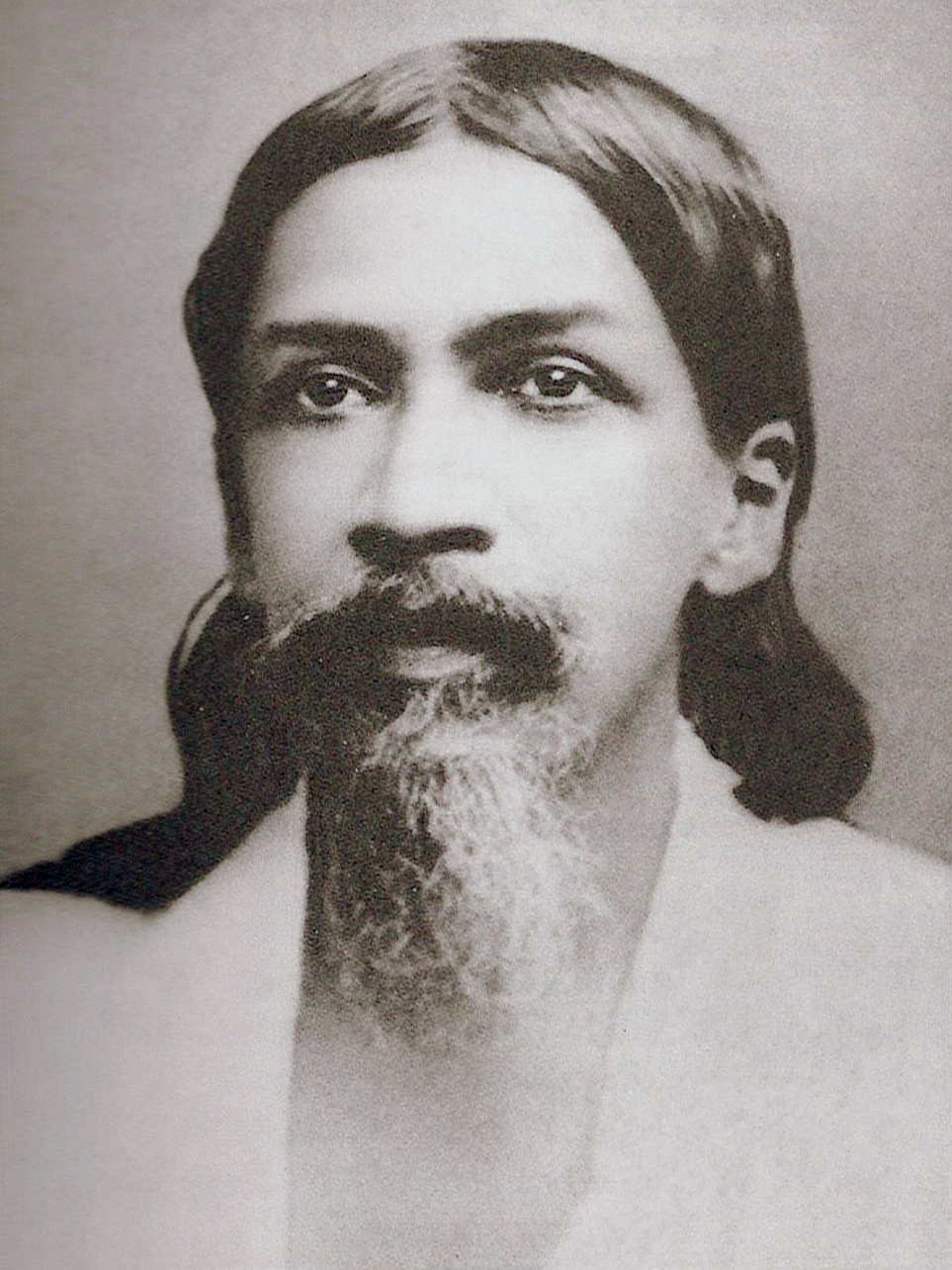 Sri Aurobindo was an Indian philosopher, yogi, guru, poet, and nationalist. Sri Aurobindo was a nationalist and one of the first to embrace the idea of complete political independence for India. He was inspired by the writings of Swami Vivekananda and the novels of Bankim Chandra Chattopadhyay.[40] He "based his claim for freedom for India on the inherent right to freedom, not on any charge of misgovernment or oppression". He believed that the primary requisite for national progress, national reform, is the free habit of free and healthy national thought and action and that it was impossible in a state of servitude.[41] He was part of the Anushilan Samiti, a revolutionary group working towards the goal of Indian independence[42] In his brief political career spanning only four years, he led a delegation from Bengal to the Indian National Congress session of 1907[41] and contributed to the revolutionary newspaper Bande Mataram. In his famous Uttarpara Speech, he outlined the essence and the goal of India's nationalist movement thus: I say no longer that nationalism is a creed, a religion, a faith; I say that it is the Sanatan Dharma which for us is nationalism. This Hindu nation was born with the Sanatan Dharma, with it, it moves and with it, it grows. When the Sanatan Dharma declines, then the nation declines, and if the Sanatan Dharma were capable of perishing, with the Sanatan Dharma it would perish. In the same speech, he also gave a comprehensive perspective of Hinduism, which is at variance with the geocentric view developed by the later day Hindu nationalist ideologues such as Veer Savarkar and Deendayal Upadhyay: But what is the Hindu religion? What is this religion which we call Sanatan, eternal? It is the Hindu religion only because the Hindu nation has kept it, after all, in this Peninsula it grew up in the seclusion of the sea and the Himalayas, because in this sacred and ancient land it was given as a charge to the Aryan race to preserve through the ages. But it is not circumscribed by the confines of a single country, it does not belong peculiarly and forever to a bounded part of the world. That which we call the Hindu religion is the eternal religion, because it is the universal religion which embraces all others. If a religion is not universal, it cannot be eternal. A narrow religion, a sectarian religion, an exclusive religion can live only for a limited time and a limited purpose. This is the one religion that can triumph over materialism by including and anticipating the discoveries of science and the speculations of philosophy. In 1910, he withdrew from political life and spent his remaining life doing spiritual exercises and writing.[40] But his works kept inspiring revolutionaries and struggles for independence, including the famous Chittagong Uprising.[43] Both Swami Vivekananda and Sri Aurobindo are credited with having founded the basis for a vision of freedom and glory for India in the spirituality and heritage of Hinduism. |
20世紀におけるヒンドゥー政体とナショナリズムの形成 シュリ・オーロビンド  シュリ・オーロビンドは、インドの哲学者、ヨーギ、グル、詩人、そして民族主義者であった。 シュリ・オーロビンドは民族主義者であり、インドの完全な政治的独立という考えを最初に受け入れた人物の一人であった。彼はスワミ・ヴィヴェーカーナンダ の著作やバンキム・チャンドラ・チャットプルダエの小説に影響を受けた。[40] 彼は「インドの自由を求める主張を、自由への固有の権利に基づいて行い、いかなる誤政や弾圧の告発にも基づいて行わなかった」。彼は、国民の進歩や改革に とって最も重要な条件は、自由で健全な国民の思想と行動の自由な習慣であり、隷属状態ではそれは不可能であると信じていた。[41] 彼は、インド独立を目的とする革命グループ、アヌシラン・サミティの一員であった インド独立という目標に向かって活動していた。わずか4年間の短い政治活動の中で、彼は1907年のインド国民会議にベンガル代表団を率いて参加し [41]、革命的な新聞『バンデ・マタラム』にも寄稿した。 有名なウッタルパラ演説で、彼はインド民族主義運動の本質と目標を次のように概説した。 私はもはや、ナショナリズムは信条でも宗教でも信仰でもないと言う。私は、それが私たちにとってのナショナリズムであるサンタナ・ダルマであると言う。こ のヒンドゥー教の国民はサンタナ・ダルマとともに生まれ、それとともに動き、それとともに成長する。サンタナ・ダルマが衰退すれば、国民も衰退する。もし サンタナ・ダルマが滅びる可能性があるならば、サンタナ・ダルマとともに滅びるだろう。 同演説の中で、彼はヒンドゥー教についての包括的な見解も示しているが、それは、ヴィール・サバーカルやディーンデーラル・ウパディヤイといった後世のヒンドゥー民族主義のイデオローグたちが展開した地動説的な見解とは相容れないものである。 しかし、ヒンドゥー教とは何だろうか?我々がサナタン、すなわち永遠と呼ぶこの宗教とは何だろうか?ヒンドゥー教がヒンドゥー教であるのは、ヒンドゥー教 の国民がそれを守り続けてきたからに他ならない。この宗教は、この半島で海とヒマラヤの山々に囲まれて育った。なぜなら、この神聖で古代の土地では、アー リア人種がそれを時代を超えて守ることを任されていたからだ。しかし、それは単一の国の枠組みに限定されるものではなく、世界の限られた一部に永遠に特有 のものであるわけでもない。我々がヒンドゥー教と呼ぶものは、永遠の宗教である。なぜなら、それは他のすべての宗教を包含する普遍的な宗教だからだ。もし 宗教が普遍的でないならば、それは永遠であることはできない。狭い宗教、宗派的な宗教、排他的な宗教は、限られた時間と限られた目的のためにのみ存在する ことができる。これは、科学の知見と哲学の思索を取り入れ、先取りすることで、唯物論に打ち勝つことのできる唯一の宗教である。 1910年、彼は政治の世界から身を引き、残りの人生を精神修養と執筆活動に費やした。[40] しかし、彼の作品は革命家や独立闘争を鼓舞し続け、有名なチッタゴン蜂起[43] もその一つである。スワミ・ヴィヴェーカーナンダとシュリ・オーロビンドは、ヒンドゥー教の精神性と遺産の中に、インドの自由と栄光のビジョンを築く基礎 を築いたとされている。 |
| Independence movement In 1924, Mahatma Gandhi wrote: This [Christian] proselytization will mean no peace in the world. Conversions are harmful to India. If I had the power and could legislate I should certainly stop all proselytizing ... It pains me to have to say that the Christian missionaries as a body, with honorable exceptions, have actively supported a system which has impoverished, enervated and demoralized a people considered to be among the gentlest and most civilized on earth.[44][45] The influence of the Hindu renaissance movements was such that by the turn of the 20th century, there was a confluence of ideas of Hindu cultural nationalism with the ideas of Indian nationalism.[5] Both could be spoken synonymously even by tendencies that were seemingly opposed to sectarian communalism and Hindu majoritism.[5] The Hindu renaissance movements held considerable influence over the revolutionary movements against British rule and formed the philosophical basis for the struggles and political movements that originated in the first decade of the twentieth century. Revolutionary movements Anushilan Samiti and Jugantar Anushilan Samiti was one of the prominent revolutionary movements in India in the early part of the twentieth century. It was started as a cultural society in 1902, by Aurobindo and the followers of Bankim Chandra to propagate the teachings of the Bhagavad Gita. But soon the Samiti had its goal to overthrow British colonial rule in India[4] Various branches of the Samiti sprung across India in the guise of suburban fitness clubs but secretly imparted arms training to its members with the implicit aim of using them against the British colonial administration.[46] On 30 April 1908 at Muzaffarpur, two revolutionaries, Khudiram Bose and Prafulla Chaki, threw bombs at a British convoy aimed at British officer Kingsford. Both were arrested trying to flee. Aurobindo was also arrested on 2 May 1908 and sent to Alipore Jail. The report sent from Andrew Fraser, the then Lt Governor of Bengal to Lord Minto in England declared that although Sri Aurobindo came to Calcutta in 1906 as a Professor at the National College, "he has ever since been the principal advisor of the revolutionary party. It is of utmost importance to arrest his potential for mischief, for he is the prime mover and can easily set tools, one to replace another". But charges against Aurobindo were never proved and he was acquitted. Many members of the group faced charges and were transported and imprisoned for life. Others went into hiding.[47] In 1910, when, Aurobindo withdrew from political life and decided to live a life of renounciate,[40] the Anushilan Samiti declined. One of the revolutionaries, Bagha Jatin, who managed to escape the trial started a group which would be called Jugantar. Jugantar continued with its armed struggle against the colonial government, but the arrests of its key members and subsequent trials weakened its influence. Many of its members were imprisoned for life in the notorious Andaman Cellular jail.[47] India House A revolutionary movement was started by Shyamji Krishnavarma, a Sanskritist and an Arya Samajist, in London, under the name of India House in 1905. The brain behind this movement was said to be V D Savarkar. Krishnaverma also published a monthly "Indian Sociologist", where the idea of an armed struggle against the British colonial government was openly espoused.[48] The movement had become well known for its activities in the Indian expatriates in London. When Gandhi visited London in 1909, he shared a platform with the revolutionaries where both the parties politely agreed to disagree, on the question of adopting a violent struggle and whether Ramayana justified such violence. Gandhi, while admiring the "patriotism" of the young revolutionaries, had "dissented vociferously" from their "violent blueprints" for social change. In turn, the revolutionaries disliked his adherence to constitutionalism and his close contacts with moderate leaders of the Indian National Congress. Moreover, they considered his method of "passive resistance" effeminate and humiliating.[49] The India House was soon to face closure following the assassination of William Hutt Curzon Wyllie by the revolutionary Madan Lal Dhingra, who was close to India House. Savarkar also faced charges and was transported. Shyamji Krishna Varma fled to Paris.[48] India House gave formative support to ideas that were later formulated by Savarkar in his book named 'Hindutva'. Hindutva was to gain relevance in the run-up to the Indian Independence and form the core ideology of the political party Hindu Mahasabha, of which Savarkar became president in 1937. It also formed the key ideology, under the euphemistic relabelling Rashtriyatva (nationalism), for the Rashtriya Swayamsevak Sangh founded in 1925,[50] and of the Bharatiya Jana Sangh (the present-day ruling Bharatiya Janata Party) under another euphemistic relabelling Bharatiyata (Indianness).[51] Indian National Congress Lal-Bal-Pal 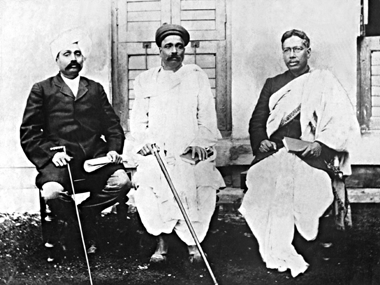 A rare photograph of Lala Lajpat Rai of Punjab, Bal Gangadhar Tilak of Maharashtra, and Bipin Chandra Pal of Bengal. The triumvirate was popularly known as Lal Bal Pal, who changed the political discourse of the Indian independence movement. "Lal-Bal-Pal" is the phrase that is used to refer to the three nationalist leaders Lala Lajpat Rai, Bal Gangadhar Tilak and Bipin Chandra Pal who held sway over the Indian Nationalist movement and the independence struggle in the early parts of twentieth century. Lala Lajpat Rai belonged to the northern province of Punjab. He was influenced greatly by the Arya Samaj and was part of the Hindu reform movement.[5] He joined the Indian National Congress in 1888 and became a prominent figure in the Indian Independence Movement.[52] He started numerous educational institutions. The National College at Lahore started by him became the centre for revolutionary ideas and was the college where revolutionaries like Bhagat Singh studied.[53] While leading a procession against the Simon Commission, he was fatally injured in the lathi charge. His death led revolutionaries like Chandrashekar Azad and Bhagat Singh to assassinate the British police officer J. P. Saunders, who they believed was responsible for the death of Lala Lajpat Rai.[52] Bal Gangadhar Tilak was a nationalist leader from the Central Indian province of Maharashtra. He has been widely acclaimed the "Father of Indian unrest" who used the press and Hindu occasions like Ganesh Chaturthi and symbols like the Cow to create unrest against the British administration in India.[54] Tilak joined the Indian National Congress in 1890. Under the influence of such leaders, the political discourse of the Congress moved from the polite accusation that colonial rule was "un-British" to the forthright claim of Tilak that "Swaraj is my birthright and I will have it".[55] Bipin Chandra Pal of Bengal was another prominent figure of the Indian nationalist movement, who is considered a modern Hindu reformer, who stood for Hindu cultural nationalism and was opposed to sectarian communalism and Hindu majoritism.[5] He joined the Indian National Congress in 1886 and was also one of the key members of the revolutionary India House.[56] Gandhi and Rāmarājya 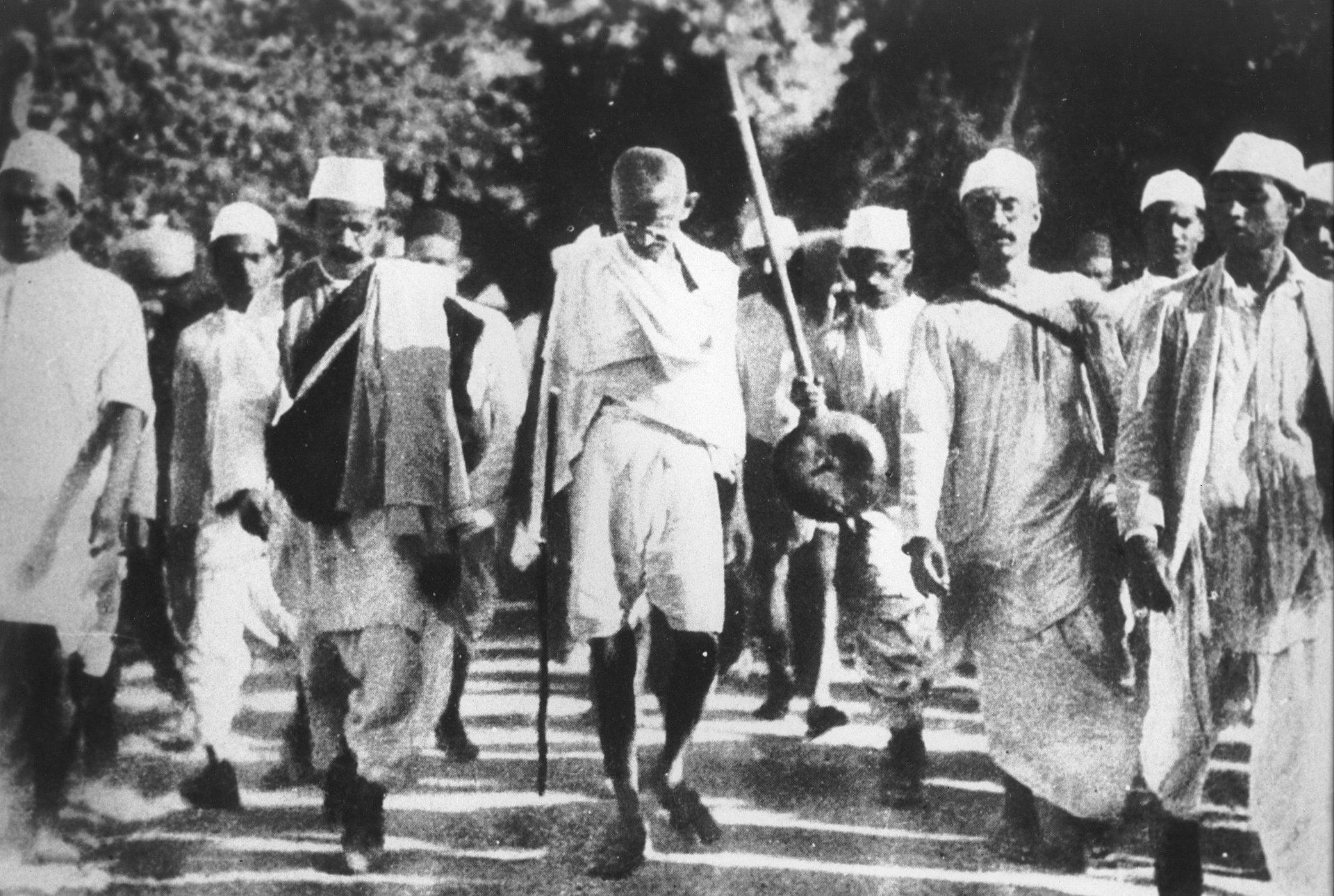 Mahatma Gandhi never called himself a Hindu nationalist, but preached Hindu Dharma and concept of "Rama Rajya". Though Mahatma Gandhi never called himself a "Hindu nationalist"; he believed in and propagated concepts like Dharma and introduced the concept of the "Rāma Rājya" (Rule of Lord Rāma) as part of his social and political philosophy.[57] Gandhi said "By political independence I do not mean an imitation to the British House of commons, or the soviet rule of Russia or the Fascist rule of Italy or the Nazi rule of Germany. They have systems suited to their genius. We must have ours suited to ours. What that can be is more than I can tell. I have described it as Ramarajya i.e., sovereignty of the people based on pure moral authority."[58] Gandhi emphasised that "Rāma Rājya" to him meant peace and justice, adding that "the ancient ideal of Ramarajya is undoubtedly one of true democracy in which the meanest citizen could be sure of swift justice without an elaborate and costly procedure".[59] He also emphasised that it meant respect for all religions: "My Hinduism teaches me to respect all religions. In this lies the secret of Ramarajya".[60] While Gandhi had clarified that "by Ram Rajya I do not mean Hindu Raj. I mean by Ram Rajya, Divine Raj, the kingdom of God," his concept of "Rama Rajya" became a major concept in Hindu nationalism.[61][62] Madan Mohan Malviya Madan Mohan Malviya, an educationist and a politician with the Indian National Congress was also a vociferous proponent of the philosophy of Bhagavad Gita (Bhagavad Gītā). He was the president of the Indian National Congress in the year 1909 and 1918.[6] He was seen as a 'moderate' in the Congress and was also considered very close to Gandhi. He popularized the Sanskrit phrase "Satyameva Jayate" (Truth alone triumphs), from the Mundaka Upanishad, which today is the national motto of the Republic of India.[63] He founded the Benaras Hindu University in 1919 and became its first Vice-Chancellor.[64] Keshav Baliram Hedgewar  Keshav Baliram Hedgewar, the founding Sarsanghachalak (or "Supreme Executive"[65]) of the Rashtriya Swayamsevak Sangh Another leader of prime importance in the ascent of Hindu nationalism was Keshav Baliram Hedgewar of Nagpur. Hedgewar as a medical student in Calcutta had been part of the revolutionary activities of the Hindu Mahasabha, Anushilan Samiti and Jugantar.[66] He was charged with sedition in 1921 by the British Administration and served a year in prison. He was briefly a member of the Indian National Congress.[66] In 1925, he left the Congress to form the Rashtriya Swayamsevak Sangh (RSS) with the help of Hindu Mahasabha Leader B. S. Moonje, Bapuji Soni, Gatate Ji etc., which would become the focal point of Hindu movements in Independent India.[67] The Rashtriya Swayamsevak Sangh started by him became one of the most prominent Hindu organisation with its influence ranging in the social and political spheres of India. In 1930, when Mahatma Gandhi started Satyagraha movement against the British Government, Hedgewar participated in the movement in his capacity and did not let the RSS join the freedom movement officially.[68] The RSS portrayed itself as a social movement rather than a political party, and did not play a central role in any of the Indian independence movement.[69][70] However, the RSS emphatically rejected the Congress policy of cooperation with the Muslims.[69] Subsequently, in 1934, the Congress banned its members from joining RSS, Hindu Mahasabha or Muslim League.[70] After the death of Hedgewar in 1940, M. S. Golwalkar became head of the organization. RSS continued to avoid participation in anti-British activities, as Golwalkar did not want to give the British colonial administration any excuse to ban the RSS.[71]: 60 After the Muslim League passed the Lahore Resolution demanding a separate Pakistan, the RSS campaigned for a Hindu nation, but stayed away from the independence struggle. When the British colonial government banned military drills and the use of uniforms in non-official organizations, Golwalkar terminated the RSS military department.[71]: 60 RSS had played no role in the Quit India Movement[72] nor the naval revolt.[67][73] |
独立運動 1924年、マハトマ・ガンジーは次のように述べた。 このキリスト教の布教活動は、世界に平和をもたらさないだろう。改宗はインドにとって有害である。もし私が権力を持って立法できる立場にあるならば、私は 布教活動をすべて確実に阻止するだろう。キリスト教の宣教師たちは、名誉ある例外はあるものの、全体として、地球上で最も穏やかで文明的な民族と考えられ ている人々を貧困化し、弱体化し、士気を低下させる体制を積極的に支援してきた。 ヒンドゥー・ルネサンス運動の影響は、20世紀の変わり目には、ヒンドゥー文化ナショナリズムの考えとインド民族主義の考えが融合するほどであった。 [5] 両者は、 宗派的な共同体主義やヒンドゥー教徒の多数派優位主義に一見対立する傾向もあった。[5] ヒンドゥー教復興運動は、英国統治に対する革命運動に大きな影響を与え、20世紀初頭に始まった闘争や政治運動の哲学的な基礎を形成した。 革命運動 アヌシラン・サミティとジュガンタール アヌシラン・サミティは、20世紀初頭のインドにおける著名な革命運動のひとつであった。1902年に、バガヴァッド・ギーターの教えを広めることを目的 として、アロービンドとバンキム・チャンドラの信奉者たちによって文化団体として発足した。しかし、間もなくサミティはインドにおける英国の植民地支配を 打倒することを目標とした。[4] サミティのさまざまな支部は、郊外のフィットネスクラブを装ってインド全土に広がったが、その一方で、英国の植民地行政に抵抗することを暗黙の目的とし て、秘密裏にメンバーに武器訓練を施していた。[46] 1908年4月30日、ムザファルプールで、革命家のクディラム・ボースとプラフル・チャキの2人が、英国人将校キングスフォードを狙って英国の護送車列 に爆弾を投げつけた。2人とも逃亡しようとして逮捕された。1908年5月2日には、オーロビンドも逮捕され、アリプール刑務所に送られた。当時ベンガル 州副総督であったアンドリュー・フレイザーがイギリスのミンタ卿に送った報告書には、1906年にシュリ・オーロビンドが国立大学の教授としてカルカッタ に来たものの、「それ以来、彼は革命派の主要なアドバイザーとなっている」と記されていた。「彼を逮捕することは極めて重要である。なぜなら、彼は主導者 であり、道具を簡単にすり替えることができるからだ」 しかし、オーロビンドに対する告発は立証されることはなく、彼は無罪となった。グループの多くのメンバーは告発され、移送されて終身刑となった。また、他 の者は身を隠した。 1910年、オーロビンドが政治活動から身を引き、隠遁生活を送ることを決意したとき、[40] アヌシラン・サミティは衰退した。革命家の一人で、裁判からなんとか逃れたバガ・ジャティンはジュガンタールと呼ばれるグループを立ち上げた。ジュガン タールは植民地政府に対する武装闘争を続けたが、主要メンバーの逮捕とそれに続く裁判により、その影響力は弱まった。多くのメンバーは悪名高いアンダマン 諸島の監獄に終身刑で収監された。[47] インド・ハウス 革命運動は、サンスクリット学者でアーリア・サマージの信者であったシャムジー・クリシュナヴァルマによって、1905年にロンドンでインド・ハウスの名 のもとに開始された。この運動の黒幕は V D サヴァルカルであったと言われている。クリシュナヴァルマは月刊誌『インド・ソシオロジスト』も発行しており、そこでは英国植民地政府に対する武装闘争の 思想が公然と唱えられていた。[48] この運動はロンドン在住のインド人社会ではよく知られていた。1909年にガンディーがロンドンを訪れた際には、革命家たちと討論の場を共にし、暴力的闘 争の採用と『ラーマーヤナ』がそのような暴力を正当化するかどうかという問題について、両者は丁重に意見が一致しないことで合意した。ガンディーは、若い 革命家の「愛国心」を称賛しながらも、彼らの社会変革のための「暴力的な青写真」には「強く反対」した。一方、革命家たちは、ガンディーの立憲主義への固 執や、インド国民会議の穏健派指導者たちとの親密な関係を嫌っていた。さらに、彼らはガンディーの「非暴力抵抗」の方法を女々しく屈辱的だと考えていた。 インド・ハウスは、インド・ハウスと親交のあった革命家マダン・ラール・ディングラによるウィリアム・ハット・カーゾン・ウィリーの暗殺事件により、間も なく閉鎖に直面することとなった。サヴァルカーも告発され、移送された。Shyamji Krishna Varmaはパリに逃亡した。[48] インド・ハウスは、後にサバルカールが著書『ヒンドゥトヴァ』で体系化した思想の形成を支援した。ヒンドゥトヴァはインド独立運動の過程で重要性を増し、 1937年にサバルカールが会長に就任した政党ヒンドゥー・マハーサバーの中心的なイデオロギーとなった。また、1925年に設立された民族奉仕団 (RSS)では「民族主義」という婉曲的な名称で、また、インド人民党(現・インド人民党)では「インド性」という別の婉曲的な名称で、それぞれ主要なイ デオロギーとなっている。 インド国民会議 ラル・バル・パル  パンジャーブのラール・ラージプート・ライ、マハーラーシュトラのバル・ガンガーダル・ティラク、ベンガルのビピン・チャンドラ・パルの珍しい写真。この3人は一般にラル・バル・パルとして知られ、インド独立運動の政治的言説を変えた。 「Lal-Bal-Pal」とは、20世紀初頭のインド民族運動と独立闘争を主導した3人の民族主義的指導者、ララ・ラージパト・ライ、バル・ガンガーダル・ティラク、ビピン・チャンドラ・パルのことを指す言葉である。 ララ・ラージパト・ライはパンジャーブ州北部の出身であった。彼はアーリア・サマージに強く影響を受け、ヒンドゥー教改革運動の一員であった。[5] 1888年にインド国民会議に参加し、インド独立運動の著名な指導者となった。[52] 彼は多数の教育機関を創設した。彼が創設したラホールの国立カレッジは、革新的な思想の中心地となり、バガット・シングのような革命家たちが学んだ大学で あった。[53] サイモン委員会に反対するデモ行進を先導していた際、彼は警棒隊に致命傷を負わされた。彼の死により、チャンドラシェカール・アザドやバガット・シングと いった革命家たちは、ララ・ラージパト・ライの死の責任者であると考えられていた英国人警察官J.P.サンダースを暗殺することになった。[52] バル・ガンガーダール・ティラクは、インド中央部のマハーラーシュトラ州出身の民族主義者であった。彼は、報道機関やガネーシャ・チャトルティーのような ヒンドゥー教の行事、牛のシンボルなどを利用して、インドにおける英国の統治に対する不満を煽り立てた人物として広く知られ、「インド動乱の父」と称され ている。[54] ティラクは1890年にインド国民会議に参加した。こうした指導者たちの影響により、インド国民会議の政治的言説は、植民地支配を「非英国的なもの」と礼 儀正しく非難するものから、ティラクの「スワラージは私の生得権であり、私はそれを手に入れる」という率直な主張へと変化した。 ベンガル出身のビピン・チャンドラ・パールは、インド民族運動のもう一人の著名な指導者であり、近代ヒンドゥー教の改革者とみなされている。ヒンドゥー教 文化ナショナリズムを標榜し、宗派的な共産主義やヒンドゥー教徒優位主義に反対した。[5] 1886年にインド国民会議に参加し、革命的なインド・ハウスの主要メンバーの一人でもあった。[56] ガンディーとラーマラージャ  マハトマ・ガンディーは自らをヒンドゥー・ナショナリストとは称さなかったが、ヒンドゥー・ダルマと「ラーマ・ラージヤ」の概念を説いた。 マハトマ・ガンディーは自らを「ヒンドゥー民族主義者」とは呼ばなかったが、ダルマのような概念を信奉し、広め、また「ラーマ・ラージヤ(ラーマ王政)」 という概念を、自身の社会・政治哲学の一部として導入した。[57] ガンディーは「政治的な独立とは、英国の下院の模倣、あるいはロシアのソビエト政権、イタリアのファシスト政権、ドイツのナチス政権を意味するものではな い。彼らには彼らの気質に適した体制がある。我々には我々の気質に適した体制が必要だ。それが何であるかは私には言えない。私はそれをラーマラージャ (Ramarajya)すなわち、純粋な道徳的権威に基づく人民の主権と表現している。」[58] ガンディーは、「ラーマ・ラージャ」とは自分にとって平和と正義を意味すると強調し、「古代のラーマ・ラージャの理想は、間違いなく、最も卑しい市民で も、煩雑で費用のかかる手続きを経ることなく迅速な正義を確実に得られる真の民主主義のひとつである」と付け加えた。[59] また、あらゆる宗教を尊重することを意味すると強調した。「私のヒンドゥー教は、あらゆる宗教を尊重することを教えてくれる。ここにラーマ・ラージャの秘 密があるのだ。」[60] ガンディーは「ラーマ・ラージャとはヒンドゥー・ラージを意味するものではない。私がラーマ・ラージャと呼ぶのは神のラージ、神の王国である」と明確にしていたが、彼の「ラーマ・ラージャ」の概念はヒンドゥー・ナショナリズムの主要な概念となった。[61][62] マダン・モハン・マルヴィヤ マダン・モハン・マルヴィヤは、教育者でありインド国民会議派の政治家でもあったが、バガヴァッド・ギーター(バガヴァッド・ギーター)の哲学の熱心な支 持者でもあった。彼は1909年と1918年にインド国民会議派の議長を務めた。[6] 彼は国民会議派では「穏健派」と見なされており、ガンディーと非常に親しい関係にあると考えられていた。彼は、今日ではインド共和国の国民的標語となって いる、ムンダカ・ウパニシャッドのサンスクリット語の句「サティヤメーヴァ・ジャヤテ(真理だけが勝利する)」を広めた。1919年にベナレス・ヒン ドゥー大学を創設し、初代学長に就任した。 ケーシャブ・バリーラム・ヘッジワル  ケーシャブ・バリーラム・ヘッジワルは、ラシュトリヤ・スワヤムセヴァク・サンガの初代サルサンガチャラク(最高執行責任者)である。 ヒンドゥー・ナショナリズムの勃興において、ナグプールのケシャブ・バシール・ヘッジワルは、もう一人の重要な指導者であった。カルカッタの医学生であっ たヘッジワルは、ヒンドゥー・マハサバー、アヌシラン・サミティ、ジュガンタルの革命活動に参加していた。[66] 1921年、彼は英国政府によって反逆罪で起訴され、1年間刑務所に収監された。彼はインド国民会議のメンバーであったこともある。[66] 1925年、彼は国民会議を離れ、ヒンドゥー・マハサバーのリーダーB.S.ムーンジェ、バプ ウジ・ソニ、ガタテ・ジなどと協力して、独立後のインドにおけるヒンドゥー教運動の中心となるRSS(ラージティヤ・スワヤムセヴァク・サンガ)を結成し た。[67] 彼が創設したRSSは、インドの社会および政治の分野に影響を及ぼす最も著名なヒンドゥー教組織のひとつとなった。 1930年、マハトマ・ガンディーがイギリス政府に対してサティヤーグラハ運動を開始した際、ヘッジワーは自らの立場からこの運動に参加したが、RSSを 公式に自由運動に参加させることはなかった。[68] RSSは自らを政治団体ではなく社会運動団体と位置づけ、 インド独立運動のどの局面においても中心的な役割を果たすことはなかった。[69][70] しかし、RSSはムスリムとの協力というインド国民会議派の方針を断固として拒絶した。[69] その後、1934年に国民会議派はRSS、ヒンドゥー・マハサバー、ムスリム連盟への加盟を自党のメンバーに禁じた。[70] 1940年にヘッジワールが死去した後、M. S. ゴルワカルが組織のトップとなった。ゴルワカルは英国植民地政府にRSSを禁止する口実を与えたくなかったため、RSSは反英活動への参加を避け続けた。 [71]: 60 ムスリム連盟がパキスタン分離独立を要求するラホール決議を可決した後、RSSはヒンドゥー国民のための運動を行ったが、独立闘争には参加しなかった。英 国植民地政府が非公式組織における軍事訓練と制服の使用を禁止すると、ゴルワルカルはRSSの軍事部門を廃止した。[71]: 60 RSSは、インド独立運動[72]にも海軍反乱[67][73]にも一切関与しなかった。 |
| Bengali Hindu Homeland Movement Main article: Bengali Hindu Homeland Movement The Bengali Hindu Homeland Movement refers to the movement of the Bengali Hindu people for the Partition of Bengal in 1947 to create a homeland for themselves within India, in the wake of Muslim League's proposal and campaign to include the entire province of Bengal within Pakistan, which was to be a homeland for the Muslims of British India. The movement began in late 1946, especially after the Great Calcutta Killing and Noakhali genocide, gained significant momentum in April 1947 and in the end met with success on 20 June 1947 when the legislators from the Hindu majority areas returned their verdict in favour of Partition and the Bengal Presidency was divided into West Bengal and East Pakistan. Post-independence See also: Partition of India After the assassination of Mahatma Gandhi by Nathuram Godse, the Sangh Parivar was plunged into distress when the RSS was accused of involvement in his murder. Along with the conspirators and the assassin, Vinayak Damodar Savarkar was also arrested. The court acquitted Savarkar, and the RSS was found be to completely unlinked with the conspirators.[74] The Hindu Mahasabha, of which Godse was a member, lost membership and popularity. The effects of public outrage had a permanent effect on the Hindu Mahasabha. Rashtriya Swayamsevak Sangh Main article: Sangh Parivar The Rashtriya Swayamsevak Sangh, which was started in 1925, had grown by the end of British rule in India.[74] In January 1948, Mahatma Gandhi was assassinated by Nathuram Godse, a former member of the RSS.[75][76] Following the assassination, many prominent leaders of the RSS were arrested, and the RSS as an organisation was banned on 4 February 1948 by the then Home Minister Patel. During the court proceedings in relation to the assassination Godse began claiming that he had left the organisation in 1946.[77] The then Indian Deputy Prime Minister and Home Minister, Vallabhbhai Patel had remarked that the "RSS men expressed joy and distributed sweets after Gandhi's death".[78] The charged RSS leaders were acquitted of the conspiracy charge by the Supreme Court of India. Following his release in August 1948, Golwalkar wrote to Prime Minister Jawaharlal Nehru to lift the ban on RSS. After Nehru replied that the matter was the responsibility of the Home Minister, Golwalkar consulted Vallabhai Patel regarding the same. Patel then demanded an absolute pre-condition that the RSS adopt a formal written constitution[79] and make it public, where Patel expected RSS to pledge its loyalty to the Constitution of India, accept the Tricolor as the National Flag of India, define the power of the head of the organisation, make the organisation democratic by holding internal elections, authorisation of their parents before enrolling the pre-adolescents into the movement, and to renounce violence and secrecy.[80][81][71]: 28 Golwalkar launched an agitation against this demand during which he was imprisoned again. Later, a constitution was drafted for RSS, which, however, initially did not meet any of Patel's demands. After a failed attempt to agitate again, eventually the RSS's constitution was amended according to Patel's wishes except the procedure for selecting the head of the organisation and the enrolment of pre-adolescents. However, the organisation's internal democracy which was written into its constitution, remained a 'dead letter'.[82] On 11 July 1949, the Government of India lifted the ban on the RSS by issuing a communique stating that the decision to lift the ban on the RSS had been taken in view of the RSS leader Golwalkar's undertaking to make the group's loyalty towards the Constitution of India and acceptance and respect towards the National Flag of India more explicit in the Constitution of the RSS, which was to be worked out in a democratically.[83][71]: 60 After the ban was revoked RSS resumed its activities.[74] The 1960s saw the volunteers of the RSS join the different social and political movements. Movements that saw a large presence of volunteers included the Bhoodan, a land reform movement led by prominent Gandhian Vinoba Bhave[84] and the Sarvodaya led by another Gandhian Jayaprakash Narayan.[85] RSS supported trade union, the Bharatiya Mazdoor Sangh and political party Bharatiya Jana Sangh also grew into considerable prominence by the end of the decade. Another prominent development was the formation of the Vishwa Hindu Parishad (VHP), an organisation of Hindu religious leaders, supported by the RSS, to unite the various Hindu religious denominations and to usher a social reform. The first VHP meeting in Mumbai was attended among others by all the Shankaracharyas, Jain leaders, Sikh leader Master Tara Singh Malhotra, the Dalai Lama and contemporary Hindu leaders like Swami Chinmayananda. From its initial years, the VHP led a concerted attack on the social evils of untouchability and casteism while launching social welfare programmes in the areas of education and health care, especially for the Scheduled Castes, backward classes, and the tribals.[86] The organisations started and supported by the RSS volunteers came to be known collectively as the Sangh Parivar. The next few decades saw a steady growth of the influence of the Sangh Parivar in the social and political space of India.[86] Ayodhya dispute Main article: Ayodhya dispute The Ayodhya dispute (Hindi: अयोध्या विवाद) is a political, historical and socio-religious debate in India, centred on a plot of land in the city of Ayodhya, located in Ayodhya district, Uttar Pradesh. The main issues revolve around access to a site traditionally regarded as the birthplace of the Hindu deity Rama, the history and location of the Babri Mosque at the site, and whether a previous Hindu temple was demolished or modified to create the mosque. Sexual and gender minorities Contrary to the lean of conservative parties in the western world, the BJP has been supported by sexual minorities such as women and LGBTQ.[87][88] The party was influential in sponsoring a serious of agitations in support of women and protests against the alleged rape and murder of a woman doctor, a movement that has been called "reclaim the night".[89][90] |
ベンガル・ヒンドゥー・ホームランド運動 詳細は「ベンガル・ヒンドゥー・ホームランド運動」を参照 ベンガル・ヒンドゥー・ホームランド運動とは、1947年のベンガル分割に際し、ベンガル州全体をパキスタンに組み入れるというムスリム連盟の提案と運動 を受けて、インド国内に自分たちの故郷を創設しようとしたベンガル・ヒンドゥーの人々の運動を指す。この運動は1946年後半に始まり、特にカルカッタ大 虐殺とノアカリ虐殺事件の後、1947年4月に大きな勢いを得て、最終的に1947年6月20日、ヒンドゥー教徒が多数を占める地域の議員たちが分離独立 に賛成票を投じ、ベンガル管区は西ベンガルと東パキスタンに分割された。 独立後 関連項目:インド分割 ナースラーム・ゴースによってマハトマ・ガンディーが暗殺された後、RSSがその殺人に関与したとして非難され、サンガ・パリヴァーは苦境に陥った。共謀 者および暗殺者とともにヴィナヤク・ダモダール・サヴァルカーも逮捕された。裁判所はサバルカーを無罪とし、RSSは共謀者たちとは全く無関係であること が判明した。ゴドセがメンバーであったヒンドゥー・マハーサバーは会員数と人気を失った。世間の激しい怒りの影響はヒンドゥー・マハーサバーに恒久的な影 響を与えた。 ラージヤ・スワヤムセーヴァク・サンガ 詳細は「サンガ・パリヴァール」を参照 1925年に結成されたラージヤ・スワヤムセーヴァク・サンガは、インドにおける英国統治の終わりまでに成長していた。[74] 1948年1月、マハトマ・ガンディーはナースィラム・ゴースェによって暗殺された RSSの元メンバーであったナースラム・ゴースによって暗殺された。[75][76] 暗殺後、RSSの多くの著名な指導者が逮捕され、RSSは組織として1948年2月4日に当時の内務大臣パテルによって禁止された。暗殺事件に関する裁判 手続き中、ゴースは1946年に組織を離脱したと主張し始めた。[77] インドの副首相兼内務大臣であったヴァラバハイ・パテルは、「RSSのメンバーはガンジーの死後に喜びを表し、お菓子を配った」と発言していた。[78] 起訴されたRSS指導者たちは、インド最高裁により共謀罪の容疑を晴らした。1948年8月に釈放された後、ゴルワカルは首相ネルーにRSSの禁止を解除 するよう求める手紙を書いた。ネルーが「それは内務大臣の責任である」と返答したため、ゴルワルカルはヴァラバイ・パテルに相談した。パテルは、RSSが 正式な文書による憲法を採択し、それを公表することを絶対的な前提条件として要求した。パテルは、RSSがインド憲法への忠誠を誓い、インド国旗として三 色旗を受け入れ、 組織の長の権限を定義し、内部選挙を実施して組織を民主化し、思春期前の子供たちを運動に参加させる前に親の承認を得ること、そして暴力と秘密主義を放棄 することである。[80][81][71]:28 ゴルワカルは、この要求に対する抗議活動を開始し、その最中に再び投獄された。その後、RSSの憲章が起草されたが、当初はパテルの要求を一切満たしてい なかった。抗議活動を再開するも失敗に終わり、最終的にRSSの憲章は、組織のトップの選出方法とプレ・アドルセンツ(思春期前の若者)の加入手続きを除 いて、パテルの希望に沿う形で改正された。しかし、憲章に明記された組織内の民主主義は「死文化」したままであった。[82] 1949年7月11日、インド政府はRSSの指導者ゴルワカルが RSSの憲章において、インド憲法への忠誠心とインド国旗への受容と敬意をより明確にするというゴルワカルの約束を考慮した結果、RSSに対する禁止令を 解除する決定がなされた。これは民主的に策定される予定であった。[83][71]: 60 禁止令が撤回された後、RSSは活動を再開した。[74] 1960年代には、RSSのボランティアがさまざまな社会運動や政治運動に参加した。ボランティアの参加が多かった運動としては、著名なガンディー主義者 ヴィノバ・バヴェが指導した土地改革運動のブードゥーダン(Bhoodan)や、同じくガンディー主義者ジャヤプラカーシュ・ナラヤンが指導したサルヴォ ダヤ(Sarvodaya)などがある。[85] RSSは労働組合のバーティヤ・マズドール・サンガ(Bharatiya Mazdoor Sangh)を支援し、政治政党のバーティヤ・ジャナ・サンガ(Bharatiya Jana Sangh)も1960年代の終わりまでにかなりの存在感を示すようになった。 もう一つの重要な動きは、ヒンドゥー教の宗教指導者たちによる組織であるヴィシュワ・ヒンドゥー・パリシャッド(VHP)の結成であった。VHPはRSS の支援を受け、さまざまなヒンドゥー教宗派を統合し、社会改革を推進することを目的としていた。ムンバイで開かれたVHPの最初の会合には、シャンカラ チャリヤ(ヒンドゥー教の聖者)全員、ジャイナ教の指導者、シク教の指導者マスター・タラ・シン・マルホトラ、ダライ・ラマ、スワミ・チンメイナンダなど の現代のヒンドゥー教指導者らが出席した。VHPは創設当初から、不可触民制度やカースト制度といった社会悪に対する集中的な攻撃を主導しながら、特に指 定カースト、後進階級、部族民を対象とした教育や医療の分野における社会福祉プログラムを立ち上げた。 RSSのボランティアによって始められ、支援された組織は、総称して「サンガ・パリヴァール」として知られるようになった。 その後の数十年間、インドの社会および政治の場において、サンガ・パリヴァールの影響力は着実に拡大していった。 アヨーディヤ論争 詳細は「アヨーディヤ論争」を参照 アヨーディヤ論争(ヒンディー語:अयोध्या विवाद)は、インドにおける政治的、歴史的、社会宗教的な論争であり、ウッタル・プラデーシュ州アヨーディヤ県アヨーディヤ市にある土地を巡るもので ある。主な論点は、ヒンドゥー教の神ラーマの生誕地とされる場所へのアクセス、その場所に建てられたバーブリー・モスクの歴史と位置、そしてそのモスク建 設のために以前そこにあったヒンドゥー教寺院が取り壊されたのか、それとも改築されたのか、という点に集約される。 性的およびジェンダーの少数派 西欧の保守政党の傾向とは逆に、BJPは女性やLGBTQなどの性的少数派から支持されている。[87][88] 同党は、女性支援やレイプ殺人容疑で告発された女性医師に対する抗議運動を後援するなど、大きな影響力を持っていた。この運動は「夜を取り戻そう」と呼ば れている。[89][90] |
| Hindutva and Hindu Rashtra Main article: Hindutva For other uses, see Hindu Rashtra. Sarkar Main article: Benoy Kumar Sarkar Professor Benoy Kumar Sarkar coined the term Hindu Rastra. In his book named Building of Hindu Rastra (হিন্দু রাস্ট্রের গড়ন) presented the idea of structural of Hindu state and directives for the socio-economic and political system of the Hindu state. He is deemed the pioneer ideologue of Hindu Rashtra. Many people identify his philosophy as 'Sarkarism'. His writings on this subject amounted to nearly 30,000 pages.[91] A complete list of his publications is contained in Bandyopadhyay's book The Political Ideas of Benoy Kumar Sarkar.[92] 1914/1921 The Positive Background of Hindu Sociology[93] 1916 The beginning of Hindu culture as world-power (A.D. 300-600)[94] 1916 Chinese Religion Through Hindu Eyes[95] 1918 Hindu achievements in exact science a study in the history of scientific development[96] In 1919, he authored a study in the American Political Science Review presenting a "Hindu theory of international relations" which drew on thinkers such as Kautilya, Manu and Shookra, and the text of the Mahabharata.[97][98] In 1921, he authored a Political Science Quarterly study presenting a "Hindu Theory of the State."[98] According to Barry Buzan and Amitav Acharya, Sarkar's works "may be the first major IR contributions by an Indian, and one of the first modern efforts to develop an indigenous Non-Western theory of IR."[98] Savarkar Main article: Vinayak Damodar Savarkar 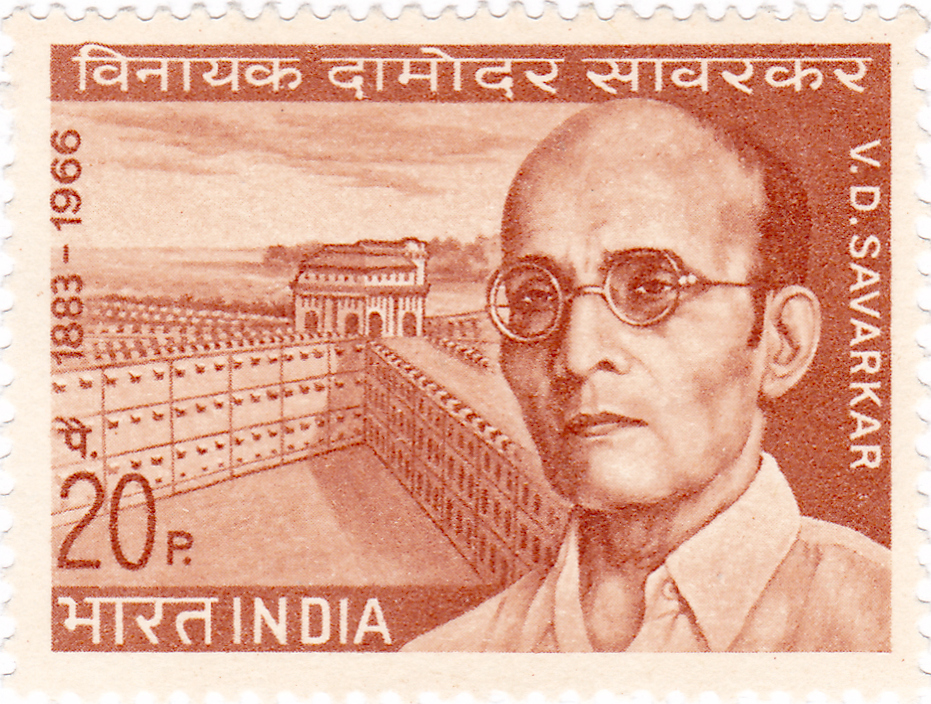 Veer Savarkar, formulator of the Hindutva philosophy, on a 1970 stamp of India Savarkar was one of the first in the twentieth century to attempt a definitive description of the term "Hindu" in terms of what he called Hindutva meaning Hinduness.[99] The coinage of the term "Hindutva" was an attempt by Savarkar who was non religious and a rationalist, to de-link it from any religious connotations that had become attached to it. He defined the word Hindu as: "He who considers India as both his Fatherland and Holyland". He thus defined Hindutva ("Hindu-ness") or Hindu as different from Hinduism.[99] This definition kept the Abrahamic religions (Judaism, Christianity and Islam) outside its ambit and considered only native religious denominations as Hindu.[100] This distinction was emphasised on the basis of territorial loyalty rather than on religious practices. In this book which was written in the backdrop of the Khilafat Movement and the subsequent Malabar rebellion, Savarkar wrote "Their [Muslims' and Christians'] holy land is far off in Arabia or Palestine. Their mythology and Godmen, ideas and heroes are not the children of this soil. Consequently, their names and their outlook smack of foreign origin. Their love is divided".[99] Savarkar had made it clear that Hindutva is not the same thing as Hinduism and it does not concern religion or rituals but the basis of India’s national character.[7] Savarkar also defined the concept of Hindu Rashtra (transl. Hindu Polity).[101] The concept of Hindu Polity called for the protection of Hindu people and their culture and emphasised that political and economic systems should be based on native thought rather than on the concepts borrowed from the West. Mukherjee Main article: Syama Prasad Mukherjee  Syama Prasad Mukherjee, who founded the Hindu nationalist Bharatiya Jana Sangh, on a 1978 stamp of India Mookerjee was the founder of the Nationalist Bharatiya Jana Sangh party, the precursor of the Bharatiya Janata Party. Mookerjee was firmly against Nehru's invitation to the Pakistani PM, and their joint pact to establish minority commissions and guarantee minority rights in both countries. He wanted to hold Pakistan directly responsible for the terrible influx of millions of Hindu refugees from East Pakistan, who had left the state fearing religious suppression and violence aided by the state. After consultation with Golwalkar of RSS, Mookerjee founded Bharatiya Jana Sangh on 21 October 1951 at Delhi and he became the first President of it. The BJS was ideologically close to the Rashtriya Swayamsevak Sangh and widely considered the political arm of Hindu Nationalism. It was opposed to appeasement of India's Muslims. The BJS also favored a uniform civil code governing personal law matters for both Hindus and Muslims, wanted to ban cow slaughter and end the special status given to the Muslim-majority state of Jammu and Kashmir. The BJS founded the Hindutva agenda which became the wider political expression of India's Hindu majority. Mookerjee opposed the Indian National Congress's decision to grant Kashmir a special status with its own flag and Prime Minister. According to Congress's decision, no one, including the President of India could enter into Kashmir without the permission of Kashmir's Prime Minister. In opposition to this decision, he entered Kashmir on 11 May 1953. Thereafter, he was arrested and jailed in a dilapidated house.[102] Syama Prasad had suffered from dry pleurisy and coronary troubles, and was taken to hospital one and a half months after his arrest due to complications arising from the same.[citation needed] He was administered penicillin despite having informed the doctor-in-charge of his allergy to penicillin, and he died on 23 June 1953. Mookherjee's death later compelled Nehru to remove the Permit system, the post of Sadar-e-Riayasat and of Prime Minister of Jammu & Kashmir.[103] Though Mukherjee was not associated with RSS, he is widely revered by members and supporters of the RSS and the Vishwa Hindu Parishad. Golwalkar M. S. Golwalkar, the second head of the Rashtriya Swayamsevak Sangh (RSS), was to further this non-religious, territorial loyalty based definition of "Hindu" in his book Bunch of Thoughts. Hindutva and Hindu Rashtra would form the basis of Golwalkar's ideology and that of the RSS. While emphasising religious pluralism, Golwalkar believed that Semitic monotheism and exclusivism were incompatible with and against the native Hindu culture. He wrote: Those creeds (Islam and Christianity) have but one prophet, one scripture and one God, other than whom there is no path of salvation for the human soul. It requires no great intelligence to see the absurdity of such a proposition. He added: As far as the national tradition of this land is concerned, it never considers that with a change in the method of worship, an individual ceases to be the son of the soil and should be treated as an alien. Here, in this land, there can be no objection to God being called by any name whatever. Ingrained in this soil is love and respect for all faiths and religious beliefs. He cannot be a son of this soil at all who is intolerant of other faiths.[104] He further would echo the views of Savarkar on territorial loyalty, but with a degree of inclusiveness, when he wrote "So, all that is expected of our Muslim and Christian co-citizens is the shedding of the notions of their being 'religious minorities' as also their foreign mental complexion and merging themselves in the common national stream of this soil."[104] After the assassination of Mahatma Gandhi, Golwalkar and Hindu Mahasabha's senior leaders such as Shyama Prasad Mukharji founded a new political party as Jan Sangh,[105] many of Hindu Mahasabha members joined Jan Sangh. Deendayal Upadhyaya Deendayal Upadhyaya, another RSS ideologue, presented Integral Humanism as the political philosophy of the erstwhile Bharatiya Jana Sangh in the form of four lectures delivered in Bombay on 22–25 April 1965 as an attempt to offer a third way, rejecting both communism and capitalism as the means for socio-economic emancipation. Contemporary descriptions Later thinkers of the RSS, like H. V. Sheshadri and K. S. Rao, were to emphasise on non-theocratic nature of the word "Hindu Rashtra", which they believed was often inadequately translated, ill interpreted and wrongly stereotyped as a theocratic state. In a book, H. V. Sheshadri, the senior leader of the RSS writes "As Hindu Rashtra is not a religious concept, it is also not a political concept. It is generally misinterpreted as a theocratic state or a religious Hindu state. Nation (Rashtra) and State (Rajya) are entirely different and should never be mixed up. The state is purely a political concept. The State changes as the political authority shifts from person to person or party to party. But the people in the Nation remain the same.[106] They would maintain that the concept of Hindu Rashtra is in complete agreement with the principles of secularism and democracy.[107] The concept of "'Hindutva" continues to be espoused by organisations like the RSS and political parties like the Bharatiya Janata Party (BJP). But the definition does not have the same rigidity with respect to the concept of "holy land" laid down by Savarkar, and stresses on inclusivism and patriotism. BJP leader and the then leader of the opposition, Atal Bihari Vajpayee, in 1998, articulated the concept of "holy land" in Hindutva as follows: "Mecca can continue to be holy for the Muslims but India should be holier than the holy for them. You can go to a mosque and offer namaz, you can keep the roza. We have no problem. But if you have to choose between Mecca or Islam and India you must choose India. All the Muslims should have this feeling: we will live and die only for this country."[108] In a 1995 landmark judgment, the Supreme Court of India observed that "Ordinarily, Hindutva is understood as a way of life or a state of mind and is not to be equated with or understood as religious Hindu fundamentalism. A Hindu may embrace a non-Hindu religion without ceasing to be a Hindu and since the Hindu is disposed to think synthetically and to regard other forms of worship, strange gods and divergent doctrines as inadequate rather than wrong or objectionable, he tends to believe that the highest divine powers complement each other for the well-being of the world and mankind."[109] |
ヒンドゥー至上主義とヒンドゥー・ラストラ 詳細は「ヒンドゥー至上主義」を参照 その他の用法については「ヒンドゥー・ラストラ」を参照。 サルカー 詳細は「ベノイ・クマール・サルカー」を参照 ベンオイ・クマール・サーカー教授は「ヒンドゥー・ラストラ」という用語を考案した。著書『ヒンドゥー・ラストラの構築』(ヒンディー語原題: Building of Hindu Rastra)では、ヒンドゥー国家の構造と、その社会経済および政治体制の指針となる考え方を提示した。彼はヒンドゥー・ラストラの思想の先駆者とみな されている。彼の哲学を「サルカリアニズム」と同一視する人も多い。 このテーマに関する彼の著作は、3万ページ近くに及ぶ。[91] 彼の著作の完全なリストは、バンドーパディヤイ著『ベノイ・クマール・サルカールの政治思想』に収められている。[92] 1914/1921 『ヒンドゥー社会学の肯定的な背景』[93] 1916 『世界大国としてのヒンドゥー文化の始まり(西暦300年から600年)』[94] 1916 『ヒンドゥーの視点から見た中国宗教』[95] 1918 『厳密科学におけるヒンドゥーの功績:科学発展の歴史研究』[96] 1919年、彼は『アメリカ政治科学評論』誌に「ヒンドゥー国際関係論」を発表し、カウティリヤ、マヌー、シュールクラーなどの思想家や『マハーバーラ タ』のテキストを引用した。[97][98] 1921年、彼は 「ヒンドゥー国家論」を提示した『政治学季刊誌』の研究論文を発表した。[98] バリー・ブザンとアミタヴ・アチャリヤによると、サルカールの著作は「インド人による初の主要な国際関係論の貢献であり、非西洋の土着の国際関係論を展開 する近代的な取り組みの最初期のものの一つである」可能性があるという。[98] サヴァルカル 詳細は「ヴィナヤク・ダモダール・サヴァルカル」を参照  ヒンドゥーナティヴィズムの理論家であるヴィーラ・サヴァルカル、1970年のインドの切手 サバルカルは20世紀において、彼が「ヒンドゥー性」と呼ぶ「ヒンドゥー」の意味について、その用語の明確な定義を試みた最初の人物の一人であった。 [99] 「ヒンドゥー性」という用語の創出は、宗教とは無縁で合理主義者であったサバルカルによる、その用語に付随するようになった宗教的な含みを排除する試みで あった。彼はヒンドゥーという言葉を次のように定義した。「インドを祖国かつ聖地とみなす者」と定義した。 こうして彼は、ヒンドゥー至上主義(Hindutva)またはヒンドゥー教徒(Hindu)をヒンドゥー教とは異なるものとして定義した。[99] この定義では、アブラハムの宗教(ユダヤ教、キリスト教、イスラム教)は対象外とし、土着の宗教宗派のみをヒンドゥー教徒とみなした。[100] この区別は、宗教的実践よりもむしろ領土的忠誠心に基づいて強調された。 ヒンドゥートヴァ運動の背景として、キルファート運動とそれに続くマラバルの反乱があったが、サヴァルカルは著書の中で「彼ら(イスラム教徒とキリスト教 徒)の聖地は遥か彼方のアラビアやパレスチナにある。彼らの神話や神々、思想や英雄は、この土地の産物ではない。したがって、彼らの名や考え方は外国由来 の匂いがする。彼らの愛は分裂している」と述べた。[99] サヴァルカルは、ヒンドゥー・ナショナリズムはヒンドゥー教とは別物であり、宗教や儀式ではなくインド国民の性格の基礎に関わるものであると明確にしていた。[7] サヴァルカルはヒンドゥー・ラシュトラ(ヒンドゥー国家)という概念も定義した。[101] ヒンドゥー・ラシュトラの概念は、ヒンドゥー教徒とその文化の保護を求め、政治・経済システムは西洋から借り入れた概念ではなく、土着の思想に基づくべきであると強調した。 ムカージー 詳細は「シャーマ・プラサード・ムカージー」を参照  インド国民会議派の創設者であるSyama Prasad Mukherjee(1978年のインド切手) ムカージーは、インド人民党の前身である民族主義人民党の創設者であった。ムカージーは、ネルーがパキスタンの首相を招待したこと、および両国における少 数派委員会の設立と少数派の権利の保証に関する両国の共同協定に強く反対した。彼は、宗教弾圧と国家による暴力を恐れて東パキスタンから逃れた何百万人も のヒンドゥー教徒難民の流入の責任をパキスタンに直接負わせたかったのである。 RSSのゴルワルカルと協議したのち、モッカージーは1951年10月21日にデリーでバーティヤ・ジャナ・サンガを設立し、初代会長に就任した。BJS は思想的にRSSに近く、広くはヒンドゥー・ナショナリズムの政治部門とみなされていた。インドのイスラム教徒に対する宥和政策に反対していた。BJSは また、ヒンドゥー教徒とイスラム教徒の両方の個人法問題を統制する統一市民法を支持し、牛の屠殺を禁止し、イスラム教徒が多数派を占めるジャンムー・カシ ミール州の特別な地位を廃止することを望んでいた。BJSはヒンドゥー至上主義の政策を打ち出し、それはインドのヒンドゥー教徒が多数派を占める政治的な 表現として広まった。 モッカージーは、インド国民会議派がカシミールに独自の旗と首相を設けるという特別地位を与える決定に反対した。国民会議派の決定によれば、インド大統領 を含む誰もが、カシミール首相の許可なしにはカシミールに入ることができなかった。この決定に反対して、彼は1953年5月11日にカシミールに入った。 その後、彼は逮捕され、荒れ果てた家に投獄された。[102] シャマ・プラサードは乾性胸膜炎と冠動脈疾患を患っており、その合併症により逮捕から1か月半後に病院に搬送された。[要出典] 彼はペニシリンアレルギーであることを担当医に伝えていたにもかかわらずペニシリンを投与され、1953年6月23日に死亡した。ムケルジーの死後、ネ ルーは許可制、サダー・リーヤーストの地位、ジャンムー・カシミール州首相の職を廃止せざるを得なくなった。 ムケルジーはRSSとは関係がなかったが、RSSおよびヴィシュワ・ヒンドゥ・パリシャドのメンバーや支持者からは広く尊敬されている。 ゴルワカル M. S. ゴルワカルは、インド人民奉仕団(RSS)の2代目指導者であり、著書『思考の束』の中で、宗教とは関係なく、領土への忠誠を基盤とする「ヒンドゥー」の 定義をさらに推し進めた。 ヒンドゥトヴァとヒンドゥー・ラシュトラは、ゴルワカルの思想とRSSの思想の基盤となった。 宗教的多様性を強調する一方で、ゴルワルカルはセム系の単一神教と排他主義は土着のヒンドゥー文化と相容れない、対立するものであると信じていた。彼は次のように書いている。 「これらの信条(イスラム教とキリスト教)には預言者は一人しかおらず、聖典も唯一であり、神も唯一である。それ以外に人間の魂を救う道はない。このような主張の不合理性は、さほど知性を必要とせずに理解できる。 彼はさらにこう付け加えた。 この国の国民の伝統に関して言えば、崇拝の方法が変わったからといって、個人がその土地の出身ではなくなり、外国人として扱われるべきだと考えることは決 してない。この国では、神をどのような名称で呼ぶことにも異論はない。この土壌には、あらゆる信仰や宗教的信念に対する愛と尊敬が根付いている。他の信仰 に寛容でない者は、この土壌の息子であるとはまったく言えない。[104] さらに、彼はサバルカーの領土への忠誠に関する見解を繰り返し、ある程度の包括性を加えて、「したがって、我々のイスラム教徒およびキリスト教徒の同胞に 期待されるのは、自分たちが『宗教的少数派』であるという概念を捨て、自分たちの外国人的なメンタリティも捨て、この国の国民的な流れに溶け込むことであ る」と述べた。[104] マハトマ・ガンジーが暗殺された後、ゴルワルカルとヒンドゥー・マハサバーのシヤマ・プラサド・ムカルジーなどの上級指導者たちは、ジャーン・サンガとして新たな政党を設立した。[105] ヒンドゥー・マハサバーの多くのメンバーがジャーン・サンガに参加した。 デーンデーラー・ウパディヤーヤ RSSのもう一人のイデオローグであるデーンデーラー・ウパディヤーヤは、1965年4月22日から25日にかけてボンベイで行われた4回の講演の形で、 かつてのBharatiya Jana Sanghの政治哲学として「総合ヒューマニズム」を提示した。これは、社会経済的解放の手段として共産主義と資本主義の両方を否定し、第三の道を提示し ようとする試みであった。 現代の記述 RSSの後の思想家であるH.V.シェーシャドリやK.S.ラオなどは、「ヒンドゥー・ラシュトラ」という言葉の非神政的な性質を強調した。彼らは、この 言葉がしばしば不適切に翻訳され、誤って解釈され、神政国家として誤った固定観念を持たれていると考えていた。H. V. シェーシャドリは、RSSの指導者として、「ヒンドゥー・ラシュトラは宗教的概念ではないため、政治的概念でもない。一般的に神政国家や宗教的ヒンドゥー 国家と誤解されている。国民(ラシュトラ)と国家(ラージヤ)は全く異なるものであり、混同されてはならない。国家は純粋に政治的概念である。国家は政治 権力が個人から個人、あるいは政党から政党へと移行するにつれて変化する。しかし、国民は不変である。[106] 彼らは、ヒンドゥー・ラシュトラの概念は世俗主義と民主主義の原則と完全に一致していると主張するだろう。[107] 「ヒンドゥトヴァ」という概念は、RSSのような組織やインド人民党(BJP)のような政党によって今も支持されている。しかし、サヴァルカーが定めた 「神聖な土地」という概念ほど厳格な定義はなく、包括主義と愛国主義が強調されている。1998年、BJPの指導者であり、当時野党のリーダーであったア タル・ビハリ・ヴァージペーイーは、ヒンドゥトヴァにおける「神聖な土地」の概念を次のように明確に述べた。「メッカはイスラム教徒にとって神聖であり続 けるだろうが、インドは彼らにとっての聖地よりも神聖な場所であるべきだ。モスクに行って礼拝を捧げてもいいし、土曜日に休んでもいい。我々には何の問題 もない。しかし、メッカかイスラム教か、インドかという選択を迫られた場合、インドを選ぶべきである。すべてのイスラム教徒は、この気持ちを持つべきであ る。この国のためにのみ生き、この国のためにのみ死ぬのだ」[108] 1995年の画期的な判決において、インド最高裁は「通常、ヒンドゥー至上主義は生き方や心のあり方として理解されるものであり、宗教的なヒンドゥー原理 主義と同義であったり、同様に理解されるべきものではない。ヒンドゥー教徒はヒンドゥー教以外の宗教を受け入れてもヒンドゥー教徒でなくなることはなく、 ヒンドゥー教徒は総合的に考える傾向があり、他の形態の崇拝、奇妙な神々、異なった教義を、間違っているとか不快であるというよりも不十分であるとみなす ため、世界の幸福と人類のために最高の神聖な力が互いに補い合っていると信じる傾向がある。」[109] |
| Hindu Rashtra movements in Nepal In 2008, Nepal was declared a secular state after the Maoist led 1996–2006 Nepalese Civil War and the following 2006 Nepalese revolution led to the abolition of monarchy of Nepal. Before becoming a secular republic, Kingdom of Nepal was the world's only country to have Hinduism as its state religion.[110][111] Thereafter, the Rastriya Prajatantra Party Nepal changed its constitution to support monarchy and the re-establishment of the Hindu state.[112] In December 2015, a pro-Hindu and a pro-monarchy protest was held at Kathmandu.[113] The chairperson of CPN-Maoist Prachanda, claimed that Muslims were oppressed by the state and assured the Muslim crowd of Muslim Mukti Morcha to give special rights to Muslims in order to appease the community and garner Muslim support as his party faced losses in the Terai region during the 2008 Nepalese Constituent Assembly election.[114] However, during the 2015 "Hindu Rashtra" campaigning in Nepal by the Rashtriya Prajatantra Party Nepal, the Nepalese Muslim groups demanded Nepal to be a "Hindu Rashtra" (Hindu Nation) under which they claimed to "feel secure" compared to the secular constitution. Nepalese Muslim groups also opined that the increasing influences of Christianity in Nepal that promote conversion against all other faiths is a reason they want Nepal to have a Hindu state identity under which all religions are protected.[115][116] Muslim leader Babu Khan Pathan who is the chairperson of the Muslim Rashtrawadi Manch Nepalgunj supported the Hindu Rashtra campaign and claimed that 80 percent Muslim citizens of Banke district supported the restoration of Hindu state. He gave the following clarification for the support of Hindu statehood in Nepal: Turning the country secular is nothing but a design to break the longstanding unity among Muslims and Hindus. So there is no alternative to reinstating the country’s old Hindu State identity in order to allow fellow citizens to live with religious tolerance. We don't need a secular identity, but want to see the country called Hindu State as this ensures safety and peace for all. We are Nepali Muslims and proud of it, because we have our unique culture of being the Muslims of this land. Everything was going well until we were ambushed by political parties’ sudden decision to declare the country secular, which is deplorable as it is clear that they acted at the behest of foreign agents. [115][116] While announcing the party manifesto for the 2017 Nepalese general election, the pro Hindu Rashtriya Prajatantra Party Nepal chairperson Kamal Thapa stated that Hindu statehood is the only means of establishing national unity and stability. He stated that the secularization of the state was done without the involvement of general public and thus, a referendum was due on the issue. Furthermore, chairperson Thapa argued that the conversion of Nepal into a secular republic was an organised attempt to weaken the national identity of Nepal and the religious conversions have seriously affected the indigenous and Dalit communities.[117] The Rastriya Prajatantra Party Nepal has stated support for a Hindu state with religious freedom and registered an amendment proposal for such on 19 March 2017.[118] On 30 November 2020, a pro-Hindu and a pro-monarchy protest was held at Kathmandu. Similar protests were held on other major cities like Pokhara and Butwal.[119] On 4 December 2020, mass protests were held at Maitighar that ended in Naya Baneshwar demanding the restoration of Hindu statehood with constitutional monarchy.[120] The protestors carried the national flags and posters of the founding father of modern Nepal, King Prithvi Narayan Shah, and chanted slogans supporting Hindu statehood. Protestors claimed the Hindu statehood is a means of national unity and well being of the people. This protest is considered one of the biggest pro-monarchy demonstrations.[121] On 11 January 2021, mass protests were held at Kathmandu demanding the restoration of Hindu statehood with monarchy. Police baton charged at the protestors around the Prime Minister's Office resulting in protestors responding with stones and sticks.[122] In August 2021, similar protests led by former Nepal Army General Rookmangud Katawal were also observed.[123] |
ネパールにおけるヒンドゥー・ラーストラ運動 2008年、ネパールは、1996年から2006年にかけての毛沢東派によるネパール内戦と、それに続く2006年のネパール革命によりネパール君主制が 廃止された後、世俗国家として宣言された。世俗的な共和国になる前、ネパール王国はヒンドゥー教を国教とする世界で唯一の国であった。[110] [111]その後、ネパール人民党は憲法を改正し、君主制とヒンドゥー教国としての再建を支持した。[112]2015年12月、カトマンズではヒン ドゥー教と カトマンズで親王政・親君主制の抗議デモが行われた。CPN-毛派の議長プラチャンダは、イスラム教徒が国家によって弾圧されていると主張し、ムスリム救 済運動のイスラム教徒の群衆に対して、ムスリムに特別な権利を与えると約束し、2008年のネパール制憲議会選挙でテライ地域で敗北を喫した自身の政党 が、ムスリムの支持を集めるために、コミュニティをなだめることを確約した 。しかし、2015年のネパール人民党による「ヒンドゥー・ラシュトラ」キャンペーン中、ネパール・イスラム教徒グループは、世俗憲法よりも「ヒン ドゥー・ラシュトラ(ヒンドゥー国民)」の方が「安心できる」として、ネパールを「ヒンドゥー・ラシュトラ」にするよう要求した。ネパール・イスラム教徒 グループは、他の信仰への改宗を促すキリスト教の影響力がネパールで強まっていることが、すべての宗教が保護されるヒンドゥー国家としてのアイデンティ ティをネパールに求める理由であるとも主張している。[115][116] イスラム教徒のリーダーであるバブ・カーン・パタンは、イスラム教徒民族主義者会議ネパールガンジ支部の議長であり、ヒンドゥー国家化キャンペーンを支持 し、バンク郡のイスラム教徒市民の80パーセントがヒンドゥー国家の復活を支持していると主張している。彼は、ネパールにおけるヒンドゥー国家の支持につ いて、次のように説明した。 世俗国家化は、ムスリムとヒンドゥーの長年の結束を断ち切るための策略に他ならない。 したがって、国民が宗教的寛容さを持って共存していくためには、この国の古いヒンドゥー国家としてのアイデンティティを復活させる以外に選択肢はない。 私たちは世俗的なアイデンティティを必要としていない。 むしろ、すべての人々の安全と平和を確保するために、この国をヒンドゥー国家と呼びたいのだ。私たちはネパール人イスラム教徒であり、それを誇りに思って いる。なぜなら、この土地のイスラム教徒としての独自の文化を持っているからだ。すべてがうまくいっていたが、政党が突然、この国を世俗国家と宣言すると いう決定を下し、待ち伏せされた。これは残念なことであり、彼らが外国の工作員の指示で行動したことは明らかである。[115][116] 2017年のネパール総選挙の党マニフェストを発表する中、ヒンドゥー教支持政党であるネパール民族主義党のカマル・タパ議長は、ヒンドゥー教国家こそが 国民の団結と安定を確立する唯一の手段であると述べた。同議長は、世俗化は一般国民の関与なしに行われたため、国民投票を行うべきだと主張した。さらにタ パ議長は、ネパールを世俗共和国に転換することはネパールの国民的アイデンティティを弱体化させる組織的な試みであり、宗教改宗は先住民族やダリット(旧 称:不可触賤民)のコミュニティに深刻な影響を与えていると主張した。[117] ネパール民族主義党は、信教の自由を伴うヒンドゥー国家を支持すると表明し、2017年3月19日にそのような改正案を提出した。[118] 2020年11月30日、カトマンズでヒンドゥー教支持派と王政支持派のデモが行われた。同様のデモはポカラやブトワルなどの主要都市でも行われた。 2020年12月4日、マイトィガルで大規模な抗議デモが行われ、ネパール憲法に基づく君主制を伴うヒンドゥー国家の復権を要求して、ナヤ・バネシュワル で終了した。[120] 抗議者たちはネパールの国旗と近代ネパールの建国者であるプリティヴィ・ナラヤン・シャハ王のポスターを掲げ、ヒンドゥー国家を支持するスローガンを叫ん だ。デモ参加者は、ヒンドゥー国家は国民の団結と幸福につながる手段であると主張した。この抗議は、君主制支持派による最大規模のデモのひとつと見なされ ている。 2021年1月11日、カトマンズで君主制を伴うヒンドゥー国家の復権を求める大規模な抗議デモが行われた。首相官邸周辺で警察がデモ隊に警棒で突撃した ため、デモ隊は石や棒で応戦した。[122] 2021年8月には、元ネパール軍将軍のルクマンガド・カタワルが主導する同様の抗議デモも発生した。[123] |
| Akhand Bharat Civilization state Ethnic relations in India Greater India Hindu revolution Hinduism in India History of India Indianisation Indocentrism Indomania Indosphere List of Hindu nationalist political parties List of Hindu organisations Religion in India Religious violence in India Revocation of the special status of Jammu and Kashmir Saffron terror |
アカン・バーラト 文明国家 インドの民族関係 大インド ヒンドゥー革命 インドにおけるヒンドゥー教 インドの歴史 インド化 インド中心主義 インド・マニア インド圏 ヒンドゥー民族主義政党の一覧 ヒンドゥー教団体の一覧 インドの宗教 インドにおける宗教的暴力 ジャンムー・カシミール州の特別地位の廃止 サフランテロ |
| https://en.wikipedia.org/wiki/Hindu_nationalism |
|
リ ンク
文 献
そ の他の情報
Copyleft, CC, Mitzub'ixi Quq Chi'j, 1996-2099
☆
 ☆
☆